SIMPLE / SMART / SUSTAINABLE / STORIES

CARLOS MONTOYA in His Element

Why Would ANYONE LITTER?
Dot Will Take Your QUESTIONS NOW
What's So Bad ABOUT NUCLEAR ENERGY?
RIGHT AT HOME with Kate Warner

SIMPLE / SMART / SUSTAINABLE / STORIES

CARLOS MONTOYA in His Element

Why Would ANYONE LITTER?
Dot Will Take Your QUESTIONS NOW
What's So Bad ABOUT NUCLEAR ENERGY?
RIGHT AT HOME with Kate Warner


Stunning Chilmark four-acre waterfront paradise. The spacious main house and guest house enjoy wonderful sunsets and unique privacy nestled between a gentle hill and a 200-acre private estate. The property is in the highly desirable Spring Point community with three quarters of a mile of private beach, endless dirt roads, walking trails, and two tennis courts. Exclusively offered $11,995,000.


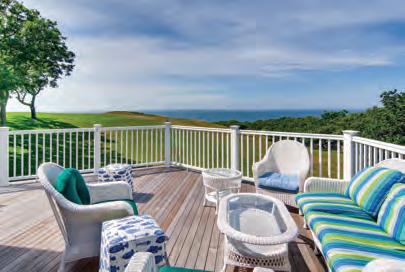

“ Look again at that dot. That’s here. That’s home. On it everyone you love, everyone you know, everyone you ever heard of, every human being who ever was … on a mote of dust suspended on a sunbeam.”
What’s your favorite locally made food or gift?

Publishers
Peter and Barbara Oberfest (publisher@mvtimes.com)
Editors
Leslie Garrett: By the Sea Salt
Jamie Kageleiry: (editor@bluedotliving.com)
MV Sea Salt in special glass containers.
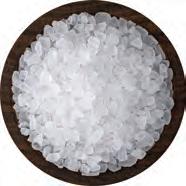

Contributing Editor
Mollie Doyle
(see contributors’ page)
Creative Director
Tara Kenny
Art Director
Kristófer Rabasca
Design/Production
Dave Plath
Nicole Jackson: Favorite local gift: An online subscription to The Martha's Vineyard Times. Call or stop by the office to purchase a gift card.

Climate Intern
Lily Olsen
(see contributors’ page)
Kelsey Perrett
(see contributors’ page)
Proofreaders Barbara Dudley Davis, Connie Berry
Ad Sales
Jenna Lambert: (adsales@mvtimes.com)
My favorite local, sustainable gift to give for the holidays is a gift card to Jardin Mahoney. They offer supplies and support for growing plants that produce nutrients for us and the wildlife we are surrounded by.
Walter and Nora McGraw
Victoria Riskin: A food basket with bread and cheese from the Grey Barn, and chocolates from Salt Rock Chocolate Co., or an assortment of nuts, honey, coffee, olive oil, or beans from the MVY Coop. Maybe I'll package them in a reusable bowl.
Bluedot and Bluedot Living logos and wordmarks are trademarks of Bluedot, Inc. Copyright © 2021. All rights reserved.

Bluedot Living: At Home on Earth is printed on recycled material, using soy-based ink, in the U.S.
Bluedot Living magazine is published quarterly (three times in 2021) by The Martha’s Vineyard Times, publishers of The Martha’s Vineyard Times weekly newspaper, Martha’s Vineyard Arts & Ideas Magazine, Edible Vineyard Magazine, The Minute daily newsletter, Vineyard Visitor, and the websites MVTimes.com, VineyardVisitor.com, and MVArtsandIdeas.com.
You can see the digital version of this magazine at bluedotliving.com. Bluedot Living is available at newsstands, select retail locations, inns, hotels, and bookstores, free of charge. Find Bluedot Living on Twitter, Instagram, and Facebook @bluedotliving.
Subscribe: Please inquire at mvtsubscriptions@mvtimes.com
–Carl Sagan


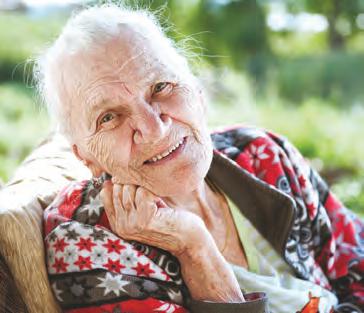
In early August, the Intergovernmental Panel on Climate Change (IPCC) released its report, and it told us what so many who work in the climate arena already knew: Climate change isn’t coming; it’s here — and it’s hitting the planet hard and fast.
The IPCC is a U.N. body whose work is the product of 234 scientists (plus 517 additional contributors) from 66 countries. This group reviewed roughly 14,000 scientific papers over three years to come up with their assessment of the state of our planet. It is an extraordinary feat — both the IPCC and its report. As The Atlantic’s Robinson Meyer puts it, “The IPCC ensures, at least in theory, that during international climate negotiations, the science is unimpeachable: Every country has agreed to the same headline findings about climate change.”
The IPCC’s role, however, is to tell us what is, not what to do about it — that's the role of policymakers around the world.
There wasn’t much in the report that could be considered good news. Except, perhaps, this: The window for decarbonizing, and therefore slowing down or stopping the impact of burning fossil fuels, is not yet firmly closed. Or think of it this way. The doctor has told us our cholesterol levels are high, and we’re already feeling the signs of heart disease. But if we follow doctor’s orders, we can still stave off a massive heart attack. We aren’t dead yet.
Which means, of course, that there is hope. Not pie-in-thesky hope, but realistic, roll-up-your-sleeves, be-the-change-youwant-to-see hope. To paraphrase activist and author Rebecca Solnit, there is darkness not just in the tomb but in the womb.
This can be a rebirth, and we can be its midwives.
When we first conceived of Bluedot Living, it was without the specifics of the latest IPCC report, but with an awareness
Geoff Currier
of its basic gist: The time to act is now. The time to connect is now.
It’s why our focus is on solutions. It’s why we want you to see what smart, motivated people are already doing, because it shows what’s possible for us, too. It’s why we want to celebrate what you are already doing. And it’s why we wanted to hone in on communities, specifically this Island community, because though climate change is a global problem, the impacts show up locally, in our ponds and forests, the place we love and call home.
Ultimately, though, the scale of change necessary will have to come from our policymakers. But we play an important role there too. We cannot let up. We must demand our elected leaders at all levels of government respond to this threat with the urgency required. Greta Thunberg tells us she wants leaders to panic. She wants them to act as if our house is on fire because it is.
Grief and anxiety are completely normal responses to the climate crisis. We must tend to our own and others’ mental health. Nature can be healing. So can binge-watching “Ted Lasso.” We must carve time in our lives for rest.
And we must rise again to what this moment requires of us.
We hear the echo of the words of Carl Sagan, who inspired the name of this magazine, that on this pale blue dot is everyone we love, everyone who ever lived. It is our only home.
We can respond to the climate crisis with despair and handwringing, or we can take this as our opportunity to reimagine how we do everything — from how we grow our food to how we shop, to how we heat and cool our homes, to how we move around on this pale blue dot. We have chosen reimagination. Rebirth.
If you are here with us, we are grateful that you have, too.
– Leslie Garrett (and Jamie Kageleiry)(“Cruising with Currier,” and “Katama Airfield.”) is an associate editor at The MVTimes. “If you’re looking for side dish for a holiday party,” he told us, “Romanesco is not only delicious but a conversation starter as well. It tastes like a cross between cauliflower and broccoli and has a mild, rather earthy taste. And visually it looks like broccoli on acid. My wife brought Romanesco home from Ghost Island the other day, cooked it up with garlic and oil, and it was great.”
We asked our contributors, “What’s your favorite made- or grown-on-MV holiday or hostess gift?” Here’s how they answered.
Mollie Doyle (“Room for Change,” “Cast Iron Skillet Irish Soda Bread”) is a writer, mother, and yoga teacher. Her favorite holiday gift is homemade granola, which she usually makes and gives in glass Mason jars. The only unsustainable aspect of this is the amount: In 2020, she made more than 50 quarts, baking in the early mornings, late at night, and between articles and yoga classes. After
that effort, she didn’t make it again until June.
Jeremy Driesen (photographer, “Cruising with Currier,” “Green Economy,” “Kate Warner”) shoots often for the Times’ magazines. His favorite? Lobster bisque from Net Result.
Kate Feiffer (“Why Do People Litter?”) is the author of 11 books for children, an illustrator, and the event producer for Islanders Write. Books are the perfect
Continued on page 57

8 What. On. Earth. Hungry for food stats?
10 Good News from All Over
14 Field Notes: An Update on Food Waste from Melissa Hackney at Vision Fellowship
16 In a Word: Radical hope
22 Nuclear Energy: What’s So Bad About It, Anyway? By Leslie Garrett.
Nuclear energy has a branding problem. (Accidents! Toxic waste!) A new generation of nuclear reactors could be the energy source we need right now
28 Carlos Montoya Relies on Nature’s Bounty By Valerie Sonnenthal
It’s not so much landscaping as managing nature around his home, and not adding much.
32 How Katama Airfield Escaped the Clutches of Developers By Geoff Currier
To preserve a 128-acre ecological gem, it took a man who loved planes more than money.
40 Buy Less, but Buy Better By Gwyn McAllister
Looking for gifts? Keep it local.
44 A Rising Tide Lifts All Boats
ByLeslie Garrett
There’s a lot of buzz around the phrase ‘green economy,’ but what exactly is it?
47 The Power of Divestment By Lily Olsen
Getting money out of fossil fuels.
50 Kate Warner’s Day in the Sun
By Kelsey PerrettShe was an early advocate for solar energy on Martha’s Vineyard. Now she’s ready to share her vision with the next generation.
38 Tell Me This: Why Would Anyone Litter? By Kate Feiffer
We explore the psychology of those who befoul our beaches and roadways.

4 Editors’ Letter
4 Contributors
17 Dear Dot
Help migrating birds! Humanely evict mice! And more...
19 Cruising with Currier
Behind the wheel of a Kia Niro EV with Greg Milne
48 Good Food
Carb comfort in a cast iron pan
55 Room for Change
Purge the plastic in your pantry (Thanks, Mollie Doyle!)
60 The Keep This Handbook
Useful Composting/Recycling/ Volunteering Info
64 Local Heroes
We Nominate M.V. Commission’s Liz Durkee Cover photo By Valerie Sonnenthal
Photo this page By David Welch

align
OF FOOD PROCESSED ANNUALLY BY THE COMPOSTER AT ISLAND
360 T O N S $
INITIATIVE'S
NINETY FIVE percent of Americans eat turkey at Thanksgiving 3
1
Cost to Vineyard towns to transport and dispose of wasted food in 2020:
720,000 2
Approximate number of Vineyard turkeys: 1,0004
40 cents of every dollar spent on food in 1975 that went back to the farm it came from ¢ 40 14.6

U.S. households that were food-insecure in 2020
10.5% 8
6,500 TONS 10
OF FOOD ARE SHIPPED OFF-ISLAND AS GARBAGE EACH YEAR
Number of Americans at Thanksgiving who will eat the classic six-ingredient green bean casserole created 60 years ago by Dorcas Reilly in Campbell’s test kitchen: 20 million 5 7 increase
14.6 cents of every dollar spent on food in 2018 that goes back to the farm it came from
IN VEGANISM OVER 15 YEARS
APPROXIMATELY
300 percent 9 % 40
OF FOOD EACH YEAR IN THE US THAT GOES UNEATEN 11
“What we’re eating is never anything more or less than the body of the world.”
– Michael Pollan, The Omnivore’s Dilemma: A Natural History of Four MealsSOURCES: 1-2 ISLAND GROWN INITIATIVE, igimv.org/foodwaste; 3. REPUBLIC WORLD, bit.ly/turkeynumber; 4. VINEYARD GAZETTE, vineyardgazette.com/news/2018/11/21/turkeys; 5. SMITHSONIAN, bit.ly/casseroleinventor; 6-7 UNIVERSITY OF MICHIGAN CENTER FOR SUSTAINABLE SYSTEMS, bit.ly/foodsystemfacts; 8. USDA ECONOMIC RESEARCH SERVICE, bit.ly/foodsecuritystatisics; 9. VEGAN NEWS, bit.ly/newvegans; 10. ISLAND GROWN INITIATIVE, igimv.org/foodwaste. 11: NATURAL RESOURCES DEFENSE COUNCIL, bit.ly/40percentwaste. GROWN FARM
DELIVERING CLEAN ENERGY BY 2023
Vineyard Wind 1 will reduce carbon pollution by over 1.6 million tons per year, an equivalent of removing 325,000 vehicles from roadways. e project will generate clean, renewable, affordable energy for over 400,000 homes and businesses across the Commonwealth.
Vineyard Wind is committed to ensuring the protection of marine habitats and minimizing any impacts to the fishing industry.

As climate change–induced wildfires worsen across the world, some locations in the U.S. have found a solution: Goats. Lani Malmberg, a goatherder from Colorado, travels the American West,

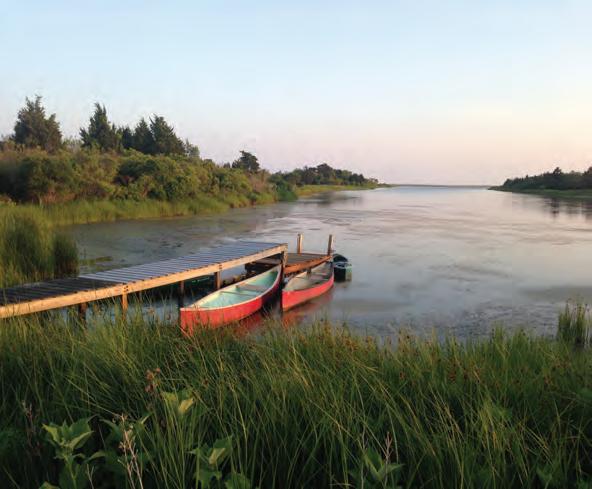
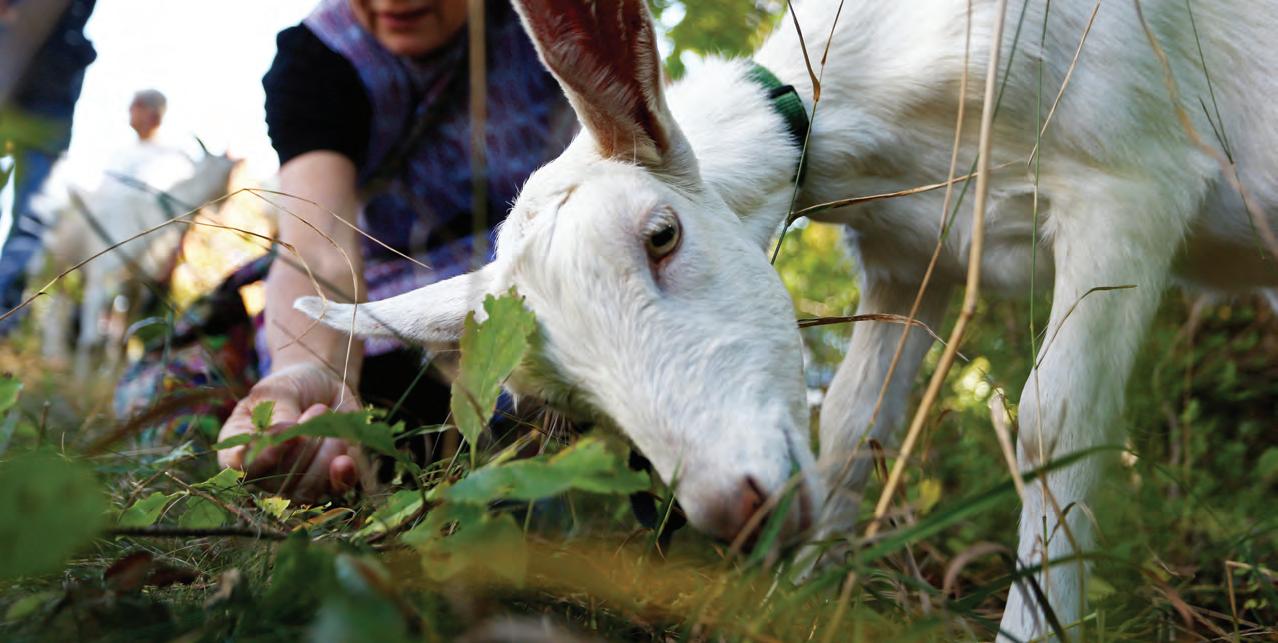
allowing her herds to graze as a fire prevention method. She is hired by local governments and private landowners. Goats can eat vegetation that other grazers can’t reach — goats can stand up to nine feet tall on their hind legs. Their waste also increases the organic matter in
soil, which means it can hold more water. In addition to reducing brush, the herds can restore land that has been burned by a previous wildfire. And adding to their usefulness, goats are able to graze on steep slopes, areas that other fire prevention methods have trouble reaching.



“And, when you want something, all the universe conspires in helping you to achieve it.”
— Paulo Coelho, The Alchemist
Goats are one of many tools that state and local agencies are employing to prevent or control wildfires, including prescribed burns and herbicide.
The past summer brought deadly heat waves to cities all over the continent, including the Pacific Northwest and British Columbia. But research shows that there’s a powerful, towering weapon in the fight against urban heat: tree canopy. Communities with more tree cover remain cooler than those without.
But in yet another instance where we see inequity exacerbated by climate change, a study of more than 3,000 communities across the U.S. indicates those with a higher number of nonwhite residents have fewer trees and less green infrastructure.
A new project aims to cool things off, at least in Los Angeles. The USC Urban Trees Initiative “combines advanced mapping technology, air quality research, and landscape architecture to show the best places to plant new trees.” It’s been put to use in two neighborhoods that lack shade, with plans to follow suit with others.
They’re called “forever chemicals” because they accumulate in humans and animals, and don’t naturally break down. Maine has banned the use of all products with per- and polyfluoroalkyl substances (PFAS) by 2030, becoming the first state to implement such strict regulations. PFAS cause a range of issues, including birth defects, infertility, cancer, and thyroid disease. And they show up in the blood of 97 percent of Americans, according to studies.
We find these chemicals everywhere from cookware to cosmetics to clothing. By 2023, manufacturers in Maine will be required to report their presence.

While other states ban PFAS in certain products, such as carpeting, Maine is leading the way on a total ban. Let’s hope others aren’t too far behind.
There’s a lot of buzz around a new initiative taking off at Pittsburgh International Airport. When faced with a problem of
honeybee swarms forcing planes to land, the airport decided to coexist with its fellow flyers, rather than eradicate them. Honeybee populations have faced stark declines in recent years. Honeybees are essential to our food supply, responsible for one in three bites of Americans’ food. Many airports, including Pittsburgh, are surrounded by natural habitat suitable for honeybees — woods, overgrown fields, and streams. What’s more, beekeeping has solved the airport’s swarm problems. Swarm traps around the airport perimeter offer a more suitable landing spot. Honeybees also act as “bio-detectives” — their honey indicates to scientists whether the airport’s levels of toxins exceed regulated air pollution levels.
A number of other airports have started similar operations.
While you might have noticed a shift to paper straws in your favorite coffee shop, or reusable bags at the grocery store, single-use plastic is still all around us. New
Zealand aims to change that. The country is paving the way in the global fight against waste with its recent promise to ban most single-use plastics by 2025.
Among the banned plastics are bags, cotton buds, cutlery, straws, and fruit labels. These items will be phased out beginning in 2022.



Despite its reputation as environmentally conscious, New Zealand is currently one of the top 10 per-capita producers of landfill waste. This ban, according to environment minister David Parker, would “ensure we live up to our clean, green reputation.”
The government has also announced funding for businesses to research alternatives to single-use plastic, showing the world that a plastic-free future is within reach.


The steel industry currently emits more than 3 billion tons of carbon dioxide annually in steel production. A new Swedish project, hydrogen breakthrough ironmaking technology (HYBRIT), is employing
an alternative way of steel production that uses hydrogen instead of carbon to remove oxygen from ore. The byproduct is water, instead of carbon dioxide.
There is currently just a pilot plant, but there are plans to build a commercial-scale demo plant that will produce 1.3 million tons of steel a year by 2026. While “green” steel might cost 20 to 30 percent more than traditional steel at first, the cost will come down as the electrolysis process and green energy sources become more efficient. Government subsidies, tariffs, and taxes could also help bring down the price.
Electric vehicles are a godsend in the urgent transition away from fossil fuel. The current problem, however, is that the infrastructure required for an all-electric fleet is lacking—there aren’t enough charging stations. Michigan has a solution.
In a groundbreaking move, Gov. Gretchen Whitmer announced that the state will
construct a wireless, dynamic charging roadway in the U.S. "Michigan was home to the first mile of paved road, and now we're paving the way for the roads of tomorrow with innovative infrastructure that will support the economy and the environment, helping us achieve our goal of carbon neutrality by 2050," said Governor Whitmer.






























While you might hear most often about reducing carbon dioxide output to fight climate change, scientists are also stressing the need to extract greenhouse gas from the atmosphere — and a carbon-capturing plant in Iceland is on the cutting edge. The plant, called Orca, was built by Climeworks, and is currently the world’s largest.
The process involves large fans sucking carbon dioxide out of the air and collecting it in filters. After the filters are blasted with heat, freeing the gas, the carbon dioxide is mixed with water and pumped into underground basalt caverns.

Nearly a billion metric tons of carbon dioxide need to be extracted per year by 2050 to reach carbon-neutral goals. While Orca can only capture 4,000 metric tons annually, Climeworks says this capacity will grow rapidly. This plant will serve as a blueprint for more of its kind around the world.

A tiny fish, famous for halting construction of a federal dam in the 1970s, has made its way off the endangered species list. The snail darter, only 3.5 inches long, is native to Tennessee.
Scientists have developed a mapping system that can help track and protect coral reefs. The Allen Coral Atlas creates high-resolution maps of the world’s coral reefs through combining local data with nearly 2 million satellite images. The maps will inform researchers and
government officials about where action is needed to protect reefs.
While only 1 percent of the ocean floor is covered by coral reefs, over a quarter of marine wildlife relies on these habitats. Increasing water temperature and acidity, caused by climate change, have destroyed about 27 percent of reefs. The map could also help scientists discover which coral species are more resistant to increasing temperatures, and could be used to restore damaged reefs.
Several once-endangered tuna species are now in the clear. Two bluefin, a yellowfin, and an albacore were either removed from the endangered species list or categorized as no longer critically endangered in September. This comes after a decade-long effort to mitigate overfishing, and speaks to the success of sustainable fisheries. In 2011, the International Union for Conservation of Nature announced that these four tuna species, among other commercially fished
tuna, were endangered. Since then, reduced quotas and improved data have allowed better tracking and management in order to protect the creatures against overfishing. These impressive species — which can grow up to six feet long and 550 pounds, and reach speeds of up to 40 mph — will remain in our oceans.
The last leaded-gasoline refinery, located in Algeria, shut down in August. Leaded gasoline has caused high levels of lead in human blood, as it pollutes the air, water supplies, crops, and soil. Vulnerable people, particularly children, are most susceptible to lead exposure’s harmful consequences.
The shutdown of Algiers Refinery comes after the U.N. Environment Programme spent decades pursuing a global ban on leaded gasoline. Scientists estimate that ending production of this toxic fuel will prevent nearly a million deaths from heart disease, stroke, and cancer each year.
Martha’s Vineyard’s primary export is not fish, or locally grown food, or Island-made crafts. It’s trash. An estimated 19,000 tons of garbage are shipped off-Island each year. Of that, 6,500 tons is food waste. Over the years, various concerned Islanders have explored ways to collect and repurpose food waste locally into valuable and environmentally friendly compost. They realized that doing this on-Island would keep decaying vegetable matter and the methane gas it produces out of landfills. It would also reduce transportation and disposal costs, and the number of trucks and boats using fossil fuels.
By 2009, the Martha’s Vineyard Commission’s Island Plan, in the works since 2006, had identified a centralized composting unit as a key strategy to transform the Island’s organic waste (any biodegradable waste that comes from a plant or an animal) into useful resources. Selecting a solution can be easier than implementing it, though, especially when the desired outcome requires action by every Islander and every Island town. People must separate their food waste at home, and compost it or regularly take it to a collection site. A site (or sites) for an in-vessel composting unit (or units) must be acquired by purchase or longterm lease. An organization, public, private, or a combination, must step up to run the entire collection, composting, and curing process. Funding — again, public, private, or a combination — must be secured. Each town must approve an agreement for the facility’s use and, potentially, all or a portion of its capital costs.
People are inspired to act when a need is urgent and personal. Massachusetts’ 2014 ban on commercial food waste in the trash stream made the problem personal for at least 18 of the Island’s restaurants and the people who work in them. Any entity that produced one ton (reduced to a half-ton in 2021) of food waste during any week of the year is required to
separate food waste and send it to a proper composting facility. And yet, seven years after the food separation law took effect, the infrastructure does not exist to collect and compost at scale.
Beginning in 2013, in anticipation of the law’s enactment, the Martha’s Vineyard Vision Fellowship, through research and interviews, identified pockets of Islanders who recognized and were discussing the problem. The board of the Martha’s Vineyard Refuse Disposal and Resource Recovery District (MVRD) had been meeting with Jim Athearn, Tomar Waldman, Jessie Holtham, Alan Ganapol, Brendan O’Neil, and others for more than a year regarding food waste composting. The town transfer stations, the town boards of health, the MVRD, the hospital, the commercial trash and recycling businesses, restaurants, and the schools were also interested. But nothing concrete was underway.
Fast-forward to today. The MVRD is well-positioned to acquire an in-vessel composting facility (together with food waste pickup and compost curing operations) for use by all six Island towns. The optimum Island-wide organic waste composting solution is in sight, potentially fully operational by 2025.
The project has come this far only because of the combined, years-long efforts of public officials, private citizens, and concerned philanthropists. By 2015, the Vision Fellowship had convened and funded an Organics Committee comprised of local leaders to study the very Vineyard challenge of finding a six-town food waste solution. The Vision Fellowship provided funds so that the committee could hire a project manager, Sophie Abrams, and consultants to help conduct the study. As part of the project, the committee initiated a food waste pickup pilot in 2016 that showed such early promise that Island Grown Initiative (IGI) took it over in 2017. IGI grew the pilot into what is now Island Food Rescue, a distinct program within IGI that works to reduce, repurpose, and recycle food waste.
The pilot’s early success also was a call to local action for the Betsy and Jesse Fink Family Foundation (the Fink Foundation). In 2019, the Fink Foundation donated an in-vessel composting unit and food waste pickup truck to IGI. This enabled Island Food Rescue to expand its capacity to prove that local, at-scale food waste
composting is economically and environmentally beneficial. At the same time, the organization launched an Island-Wide Food Waste Initiative to reduce food waste on Martha’s Vineyard by 50 percent by 2030 (ReFed, a national nonprofit working to end food loss and waste across the food system, created by the Fink Foundation, has also set that goal for the entire country). A component of this effort has been to join the push for an Island composting facility. The initiative’s manager from 2019–21, Eunice Youmans, devoted the majority of her time to developing IGI’s Island Food Rescue program and to supporting the Organics Committee’s efforts toward an Island-wide composting solution.
This year, the Vision Fellowship has awarded a grant, its fourth, to the Organics Committee so that it can continue its efforts for the next two years. Woody Filley has joined as project manager, and James Robinson, a 2017 undergraduate Vision Fellow who is earning his master’s degree in public education from the University of Massachusetts Amherst, is the project intern. Woody and James are working with the Organics Committee and leading the extensive, coordinated public policy activities, including significant engagement with local public officials, and presentations to town officials and at town meetings through 2023, that are necessary to facilitate the creation of an Island composting operation capable of processing all of the Island’s food waste by 2025. For this to become a reality, we must all act now to address the problem with a comprehensive, well-planned Island-wide solution.
• L et your town leaders know that you want your town to participate in an Island-based, in-vessel composting facility.
• Collect kitchen scraps in a small countertop container. To collect multiple full crocks before making a transfer station trip, buy a five-gallon plastic bucket with an airtight lid.
• For easy cleanup, line the bucket bottom with a paper towel. Then the food scraps easily dump out.
• Compost at home, or take your full compost buckets to any Island transfer station, or IGI’s Thimble Farm, where drop-off is free through 2021.





In the summer of 2005, I sat across a table in a restaurant with my friend. We had just heard that Canada, where we both lived, had legalized gay marriage. My friend had marched, petitioned, lobbied for many years, though he insisted he never planned to marry. “We worked so long for this,” he said. “And then …” He shook his head. “It’s like it happened overnight.”
I think of that exchange often when I join those working so hard to address the climate crisis. We march, we petition, we lobby. And then … one day, we hear that Harvard has agreed to divest from fossil fuels. That a species is off the endangered list. That renewables are powering entire countries. And though they might seem like small victories, they point to the possible.

They point toward a future that we can’t yet see, can scarcely imagine.
The philosopher Jonathan Lear calls this “radical hope.” Radical hope requires that we summon the ability to imagine solutions, despite what’s happening around us. Radical hope is not to be confused with more passive optimism. As Lear puts it, “Radical hope anticipates a good,” although we may not yet be able to conceive of how that hope will take shape. Radical hope is not the stuff of pithy phrases or bromides, rather it asks us to exhibit courage and
flexibility and a creativity to respond to challenges. To see radical hope in action, look no further than Greta Thunberg, the Sunrise Movement, Indigenous water protectors, and so many others who refuse to give in.
Radical hope is not about ignoring the grief and fear I and, perhaps, you feel as we absorb the magnitude of the climate crisis. But I take courage in the work being done by these activists, young and old — those who, in Lear’s words, “facilitate a creative and appropriate response to the world’s challenges.”
Feeling both the fear and the promise is what radical hope is. It reminds us that our world continues to hold surprises. Victories that are small until, suddenly, they are big.
[ rad-i-kuhl hohp ]
equivalent to taking 325,000 cars off the road annually — Doba pointed out that wind power remains just a part of our clean energy future. “Each wind farm is a big leap forward but incremental at the same time,” he said. In other words, it’s not a replacement for solar panels so much as a companion for them. As for cost, “bills are complicated,” says Doba. While it remains unclear if energy costs will go down, he says, it’s safe to say that your bill will not increase because of Vineyard Wind.
How can we keep our cars rodent-free? And can I give migrating birds a hand?
Dot answers your thorniest questions from a perch on her porch.

Dear Dot,
I was considering getting solar panels on my roof but with the approval of Vineyard Wind, should I bother? And how will Vineyard Wind affect my power bill?
– Charlotte Duncan, Edgartown
Seems a number of us are confused about how, exactly, Vineyard Wind affects our power supply and our pocketbooks so I took your question to Andrew Doba, a spokesperson for Vineyard Wind. While touting the benefits — the 800-megawatt project will power 400,000 homes and businesses and reduce carbon emissions
About 15 years ago my house sitter threw away all the mouse poison I had left around our barn and the outside of our home. She rightly pointed out that I was potentially killing the wildlife and she feared that our cat might get poisoned too. She needn’t have worried about Jessie the cat since she isn’t a hunter. But it isn’t unusual for us to come home after a trip to a mouse nest in our car or engine. A mouse once popped out of our hood onto the ferry! I assumed they were attracted to our car by the Cheerios our then-toddlers dropped. But now we have teens and a new Cheerio-free electric vehicle and still we came home to a mouse nest in the glove box! What should I do?
– Rona, West Tisbury
hoses and upholstery, are often made of organic materials such as soy, peanut oil, and rice husks, making them a veritable buffet for hungry critters. He recommends adopting more than one solution to thwart tiny intruders. “You can wrap your engine in screening or mesh,” he says, though he admits “that’s a pain.” A bit easier is to stuff any openings in the engine with steel wool. Hanjian recommends snap traps placed on top of your tires, though what if we prefer an, ummm, less violent solution? I ask, side-eyeing Bobcat, who has dispensed with the mouse entirely and is performing his feline ablutions.
Rodenticide, suggests Hanjian. I blanche.
The kinder, gentler Jenna Lambert, the director of marketing and ad sales at The MV Times, had a mouse in her Toyota hybrid Rav4 last year and, on the advice of the dealership, sprayed a homemade blend of peppermint oil and coconut oil, she says. Voila. Adios Mickey. Colleague (and Bluedot contributor) Kelsey Perrett sprayed peppermint on dryer sheets and stuffed them in the glove box, seat pockets, and side doors. Which also eliminated worry about the oil potentially staining or discoloring her car interior.
Dear Rona,
Mice are wily. An adolescent mouse can squeeze into a space roughly the size of a dime. Give them a hint of cold weather and they’re on the hunt for some winter digs that will keep them cozy. And seldom-used cars — so many nooks and crannies! So easy to access! — act like a well-lit vacancy sign. (As appealing, apparently, is my fireplace where, as I tap away at my keyboard writing this, my cat captures a tiny mouse in his jaws. I had wondered about Bobcat’s recent fascination with the fireplace. Now I get it.)
But while utterly adorable — those little ears! those teensy whiskers — mice can be very destructive. Tim Hanjian owner/operator of Eco Island Pest Control in Oak Bluffs gets lots of calls about rascally rodents. Car parts, including wires,
While Hanjian hasn’t personally had much success with peppermint, he’s all for sticking with what works.
Rumor has it that spraying Pine Sol on your wires acts as an effective deterrent too though I didn’t find anyone who’d tried it. (Note to self: Put PineSol soaked dryer sheets in fireplace.)
There are a few other things you can do to make your car a no-go zone for rodents:
• Remove leaf debris near your car, which can create something of a bridge to a more permanent four-wheeled residence. But don’t use a leaf blower.
• Store your car with the hood lifted, thereby making it less cozy, warm and attractive.
• Start your car a couple of times a week or, if you’re off-Island for long periods of time, enlist someone to do it for you.
• Clean out any debris, especially food.
And, if all else fails, Bobcat is by the phone awaiting your call.
Birds will be migrating south any day now. Is there anything I can do to help make their trip better?

 – Elle G., Vineyard Haven
– Elle G., Vineyard Haven
Though the Vineyard tends to miss a lot of the spring migrators, fall is a wonderful time to give warblers, sparrows, flycatchers, virios, and others an assist as young ones tend to follow the coast south, says the birdly named Matt Pelikan, an Oak Bluffs-based naturalist whom many of you know as the “Wild Side” columnist for The MV Times. And these guys can use our help! “The nature of migration is really intensive,” says Pelikan. “When birds are migrating, they’re running marathons.”
Metaphorically, of course. Their little legs couldn’t possibly run 26 miles let alone the up to 600 miles the American Bird Conservancy says migrating birds travel daily at approximately the same
speed as a car on the highway.
But, like any marathoner, they need water. Lots of it, says Pelikan, who urges us to put out a dish of water on the railing of our deck if we don’t have a bird bath. And if we do have a bird bath, we must ensure that it’s kept clean, with fresh water.

But they also need fuel, says Pelikan, because migrating is so energyintensive. “A lot of the migrants that come through here are much more insect eaters than seed eaters,” he says. That’s important during migration because insects are higher in fat, which these birds need. There isn’t much we can do to ensure a steady supply of insects though we could put out a tray of mealworms, he says, which you can get at SBS in Vineyard Haven. A longer term solution, says Pelikan, is to create a bird-friendly yard that supports insect populations. What that means, he says, is getting away from a closely mowed lawn, having as many native plants as possible (Pelikan recommends blueberry, goldenrods, native asters, even sunflowers and coreopsis. Birds
love beach plums and will take a big chunk out of each before moving on to the next, he laughs.) Let your plants grow tall then let them go to seed. For those neatniks among us, perhaps even just a section of your yard could be left a bit more wild looking. If you act fast, you can get native Vineyard plants via Polly Arboretum’s online sale before October 31, 2021. You can also get in touch with Pelikan’s employer Biodiversity Works, which will help you create a bird-friendly yard. (info@ biodiversityworks.com)
For birds who overwinter, your birdhouse can provide a warm place to cozy up but ensure that you’ve cleaned it out so that the new tenants aren’t exposed to parasites.
For this issue's Cruising with Currier, I took to the dirt roads of West Tisbury with Greg Milne, a project architect and co-owner of South Mountain Co. But a few days before our ride, Greg wrote and said that his coonhound, Nessie, had just gotten skunked, and there was a little l’eau de skunk lingering in the car. Greg said he’d work on the odor, and we agreed to meet and go for a ride anyway.
As I pulled into the driveway at South Mountain in West Tisbury, Greg’s 2019 Kia Niro was hooked up to one of four charging stations. He came over to greet me, joined by Nessie,
who was mercifully skunk-free.
“The reason I got an EV,” Greg said as we headed to the car, “was that South Mountain gave us all fuel cards to pick up the cost of fuel, since we all do a lot of driving. Then they gave us the choice of either having a fuel card, or getting a certain amount that would go toward the down payment of an electric vehicle.”
Greg thought that was a great idea, and he got a 2016 Kia Soul, the forerunner of the 2019 Niro that he now drives. As soon as South Mountain rolled out the incentive, several people coincidentally got the same car. “When we were all charging at the same time,” Greg said, “it was like Kia Souls on parade.”
One problem with Greg Milne’s first Soul was that it didn’t

have great range. In the winter, since it takes more to keep the engine warm in cold weather, he got only 85 miles per charge. To put things in perspective, from Woods Hole to Boston is about 75 miles, but even in the summer he only got around 135 miles per charge. So he traded his 2016 Soul for the 2019 Niro model, which he began leasing last September. The new car gets somewhere around 350 miles per charge, one of the best ranges available in an EV today. In fact, he had just returned from a trip up to Mount Desert Island in Maine, and only had to stop to recharge once on the way up.
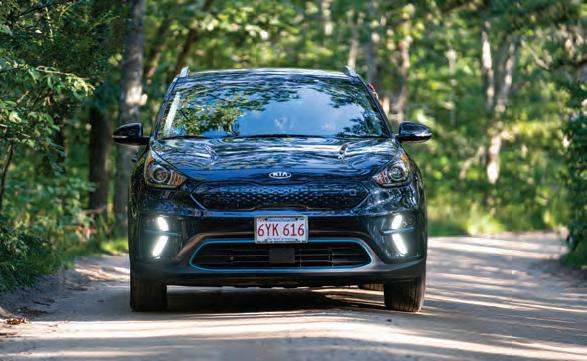
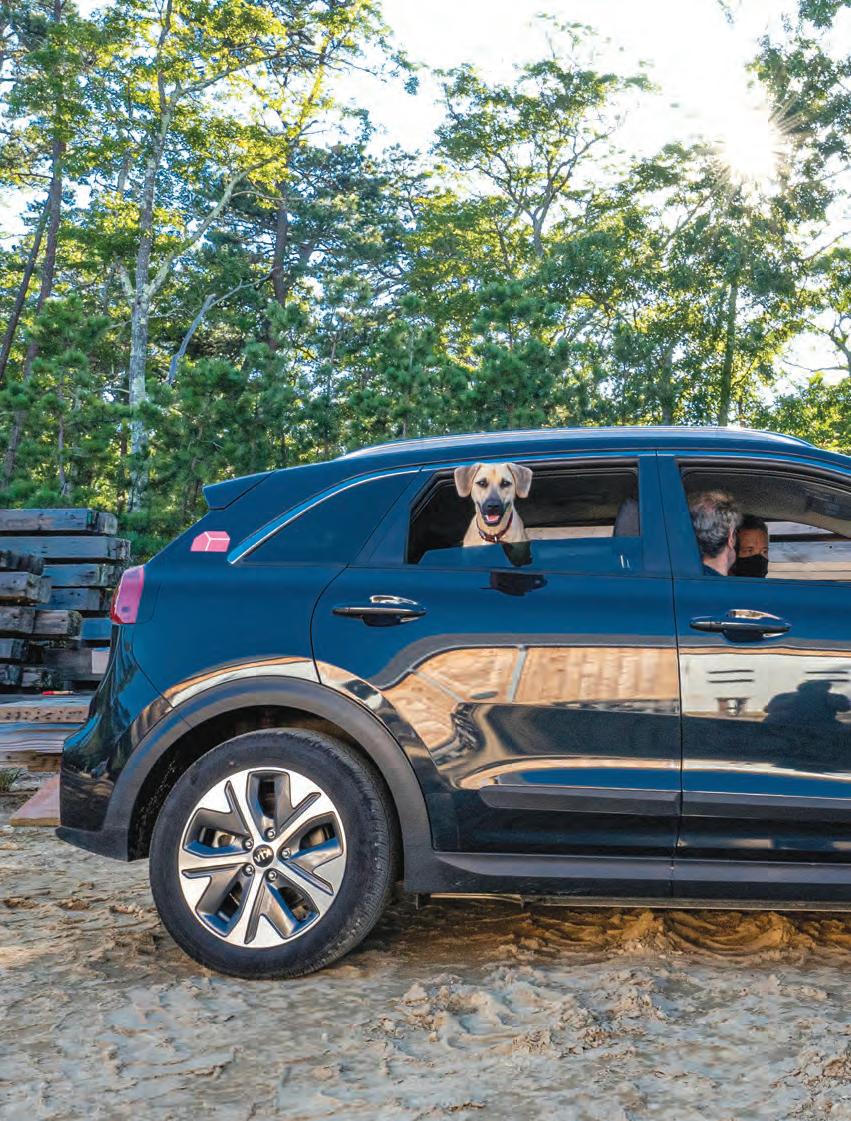
Greg explained that he has three ways to charge the batteries. He generally uses his level 1 outlet to top off a charge. South Mountain has four level 2 chargers, which are


more powerful and run off solar panels around the back of the building, making it not only convenient, but there’s no charge. That’s where Greg does the bulk of his charging. A level 2 charger can come to a full charge in six or seven hours. Cronig’s also has four level 2 chargers available for free to the public. Sometimes Greg charges when he goes shopping. Level 3 chargers are located at high-powered stations you find on the road; an app can guide you to locations. A level 3 charge generally takes between an hour to an hour and a half, and they’re often found around malls or grocery stores. “I plan my trips off-Island around charging the batteries,” Greg said. “I like to charge around mealtime, and take a natural break where I can get out, walk Nessie and stretch my legs, and get some

Greg said that driving electric cars can be a good influence on kids. He has a 10- and a 13-year-old, and said that having an electric car has heightened the kids' awareness of the environment. “They’ll spot other electric cars,” he said, “and say, ‘Looks like that person is doing good things for the environment too."
food. Charging at these level 3 chargers usually costs around 30 cents a minute, so if it takes 100 minutes, it costs around $30, still cheaper than filling up with gas.”
We set out from the South Mountain parking lot to explore the dirt roads that stretch for miles around the offices, Greg and I in the front seat, Nessie in the back.
Greg grew up in Barre, Vt., and said he misses the skiing, hiking, and traveling around on the dirt roads in his native state. “I think Vermont is one of the few states where there are more dirt roads than paved roads,” he said. The only complaint Greg has about his Kia Niro is that he has been told that the Niro is fairly lightweight, so it doesn't get great traction in the snow, which is a concern when it comes to winter trips to Vermont.
But today was a beautiful August afternoon, no snow in sight, and as we headed out of the parking lot, we took a right-hand turn to look at the South Mountain barns. “Since sustainability is such a critical part of everything we do at South Mountain,” Greg said, “this is where we salvage and reclaim a lot of timber that was used before on other jobs, all over the country.”
When old buildings are being torn down, people will contact South Mountain and have the lumber trucked here. “It’s beautiful to be able to use this stuff,” Greg said. “The lumber can be 100 years old or more, and it comes from barns, hospitals, and various buildings all over the country. We even got the boards from the Oregon State Institution where they filmed One Flew Over the Cuckoo's Nest. Sustainability bleeds into everything we do here; we’re very conscious of the carbon footprint.” Greg explains that as an architect, he loves to walk around out in the yard and see what lumber is available to him, and think about how he can work it into his jobs.
We concluded our back roads ride back at the South Mountain parking lot, where Greg said that driving electric cars can be a good influence on kids. He has a 10- and a 13-year-old, and said having an electric car has heightened the kids' awareness of the environment. “They’ll spot other electric cars,” he said, “and say, ‘Looks like that person is doing good things for the environment too.’ And they’ll start talking about what else they can do for the environment beyond the car, like recycling and composting. Actually, I think the schools on the Island are doing a great job of talking about these issues … we certainly never talked about stuff like this when I was a kid.”
All in all, Greg gives his Kia Niro high marks. He’s pleased with the range of the car, and likes its looks. It has a fair amount of room, enough to get to Maine and back with two kids and a dog — it was a little crowded but they made it.
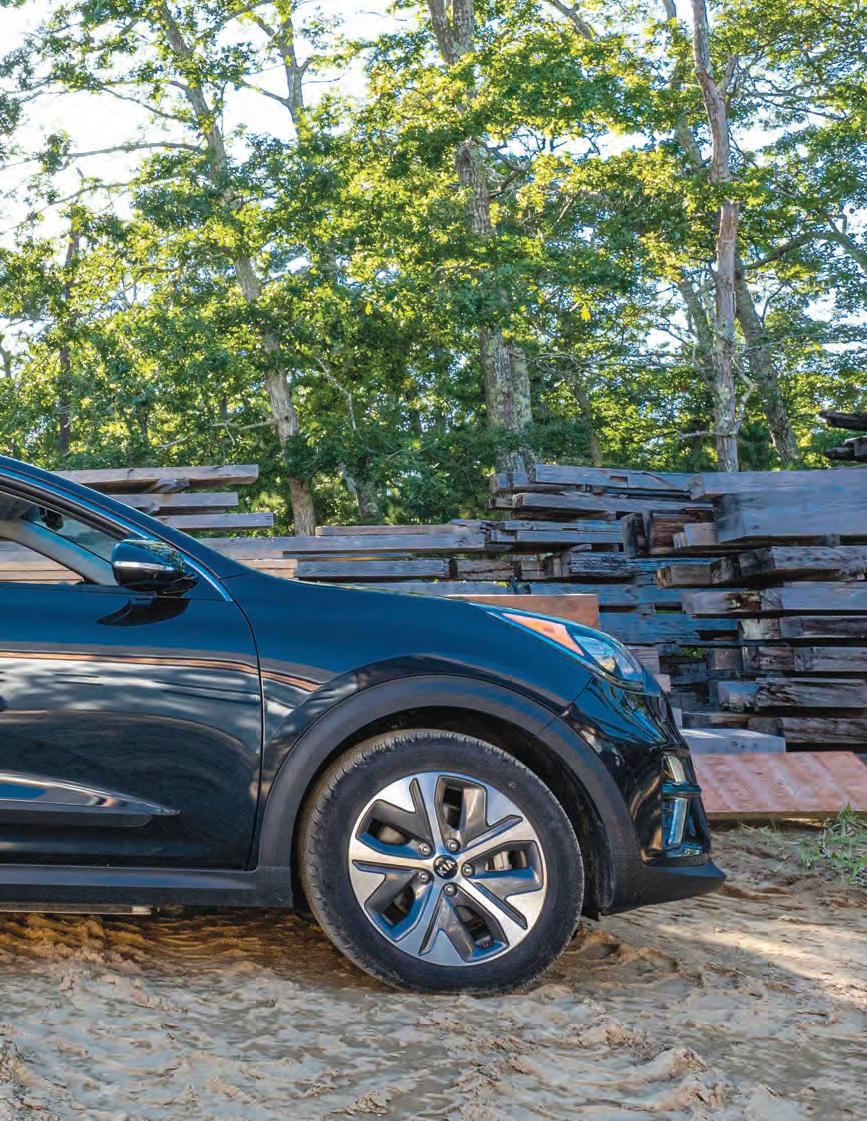
“It’s also affordable,” Greg said. He leases the car for around $300 a month. A quick check online found used 2019 Niros going for between $15,000 and $25,000, depending on the mileage. He also was able to get a $2,500 federal rebate, in addition to a little less than that from the state.
The operating costs are considerably lower than a gas-driven vehicle as well, starting with the fact that there’s no gas to buy. Greg recently called up the Kia dealer in Hyannis and asked them what he should do for the 10,000mile service, and they said they could look it over, maybe tighten a bolt or two, but there’s no oil to change, so there’s really not much for them to do.
“Add to that what is perhaps the best reason of all for buying an electric vehicle,” Greg said: “You’re doing the right thing.”
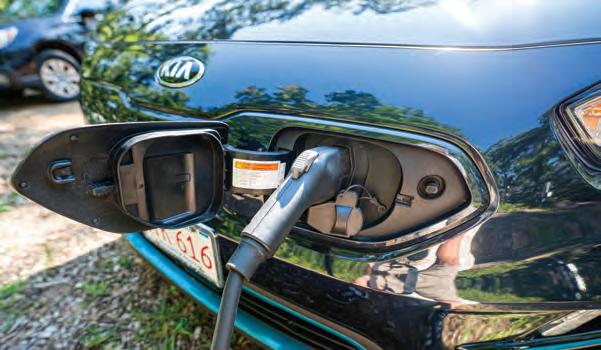
Mercifully, neither Nessie, who rode in the back seat, or the car, had any signs of being skunked.Greg can charge the Kia right in the South Mountain parking lot.

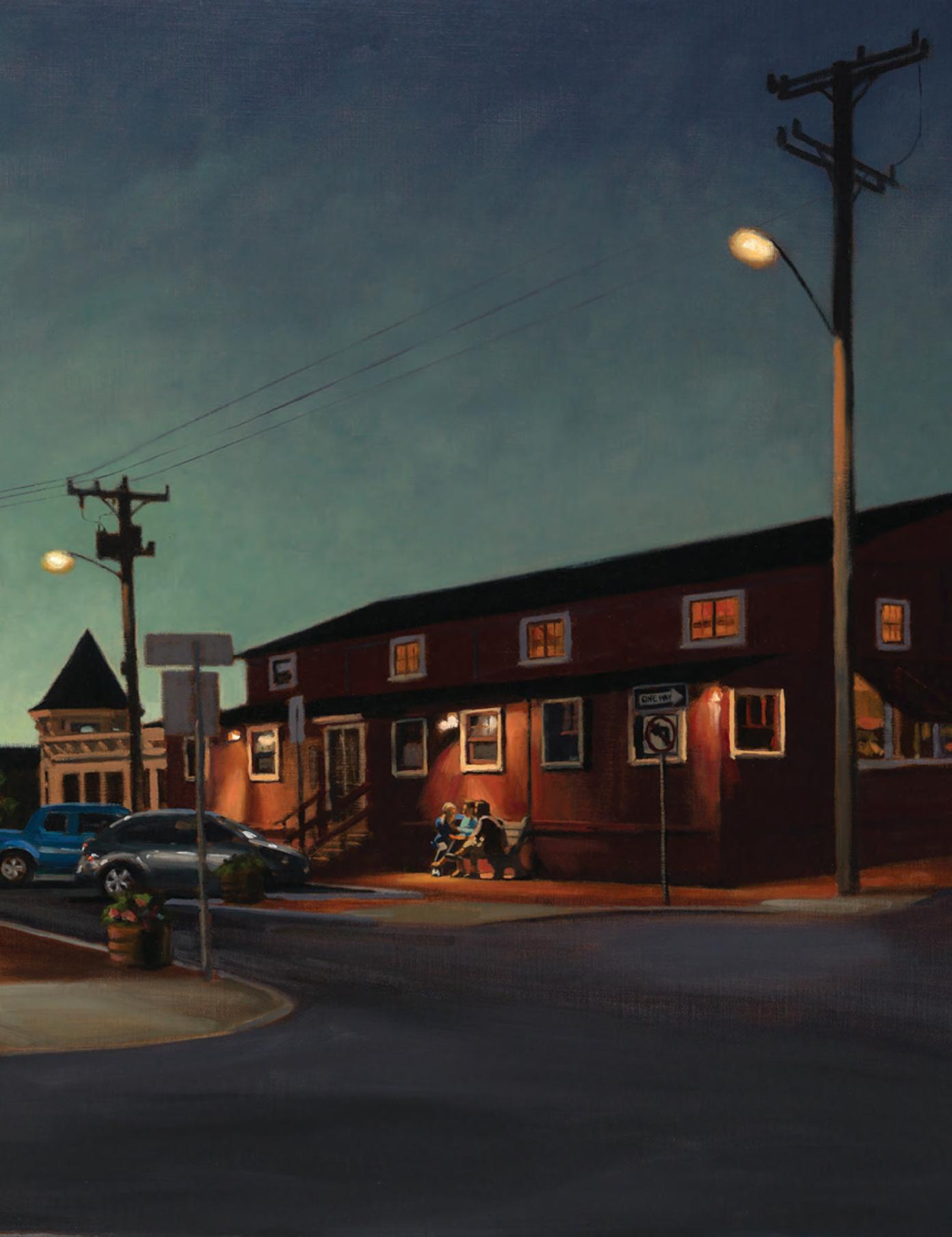
In late March 2020, while Eastern Massachusetts — indeed the world — began tracking COVID numbers and fearing trips to the grocery store, the dismantling of Plymouth’s Pilgrim Nuclear Power Station, decommissioned in 2019, continued on schedule.
Dismantling a nuclear power plant is no simple feat, due primarily to its radioactive waste. As Rich Salzberg reported for The MV Times, “Pilgrim has 1,156 fuel rods in 17 dry storage casks. These are giant stainless steel cylinders nested in giant concrete cylinders. In the plant’s spent fuel pool, there are 2,958 fuel rods.”
Many applauded the decommissioning of Pilgrim, and hope to see the remaining 55 commercially operating nuclear power plants in the U.S. follow suit. They insist that nuclear energy is too dangerous; that waste disposal is too massive and longterm a problem; that the materials necessary for nuclear energy could fall into the hands of terrorists or a rogue government. Sure, nuclear energy might have been a necessary evil, they say, but now we have affordable solar. We have wind.
Others, however, argue that to achieve the necessary low-carbon energy future
we require, the U.S. doesn’t have time to wait for renewables to scale up; that renewables require too much land; that their energy output can be sporadic. That nuclear isn’t the answer, but it’s a key part of it. And that the cons of nuclear energy — the radioactive waste, accidents, pluto nium falling into the wrong hands — are exaggerated. While they don’t dismiss the risks that nuclear poses, they argue that the need for rapid-scale decarbonization makes the risks worth it.
But are the risks worth it? And is this debate moot, given the rising costs of nuclear reactors versus the plummeting costs of wind and solar? Is investing in nuclear power another way governments and industry delay acting on climate change, as some critics accuse?
Given that Biden’s climate adviser, Gina McCarthy, according to an April 1 Bloomberg article, said that nuclear energy should be one of the power sources eligible for a national clean energy mandate via the Build Back Better plan, it’s clear the conversation is far from over.

Put simply, when atoms are split — a process called fission — a tremendous amount of energy is released. Uranium and its resulting byproduct, plutonium, are the most common elements in nuclear power reactors. The energy released heats water into steam, which in turn spins tur bines to produce electricity. Paul Hawken, author of Regeneration: Ending the Climate Crisis in One Generation, has called it “the most absurd way humanity has ever invented to boil water.” Histor ically and almost universally, we’ve relied on coal or gas to do the same thing. But where coal and gas emit greenhouse gases, nuclear emits far less — 10 to 100 times less than coal, for instance.
“I see [nuclear energy] as an essential tool,” says Jacopo Buongiorno, TEPCO Professor of Nuclear Science and Engineering, and director of the Center for Advanced Nuclear Energy Systems at the Massachusetts Institute of Technology

We can thank nuclear fusion for the sun and the stars, and here on earth, nuclear fission gives us a zero-carbon energy source. But nuclear’s magic can be dark — there are radioactive waste, weapons, and accidents. Despite those risks, does our urgent need to reduce carbon make nuclear energy our best bet right now?
support in Congress for nuclear.”
Dr. Sweta Chakraborty, a risk and behavioral scientist, agrees with Buongiorno, calling nuclear “the only carbon-free energy source that can deliver electricity 24/7/365,” and noting that it already supplies more than half of the carbon-free electricity in the U.S., though renewables play a necessary and key role too, she says.
Nuclear plants are “prohibitively expensive,” says a 2021 report from the Union of Concerned Scientists (UCS) titled “‘Advanced’ Isn’t Always Better,” noting the expense makes it unappealing to private investment and fuels public skepticism of nuclear as a viable option.
Ellie Johnston, climate and energy lead with Climate Interactive, a not-forprofit think tank that grew out of MIT Sloan School of Management, and that models the impacts of climate change,
sees nuclear as part of the mix, “but we see renewable energy growing much, much more. And one of the big reasons for that just comes down to the economics of it. Solar and wind costs have been falling precipitously in the past decade-plus. And when we look at nuclear, that’s not the Buongiorno concedes that cost has been an impediment to nuclear’s growth. Projects in the U.S. and Western Europe, he says, have had cost overruns and schedule delays. “These are complex machines,” he reminds us. Consequently, “we need a change,” he says. “And the change is a change in technology toward … small modular reactors, or
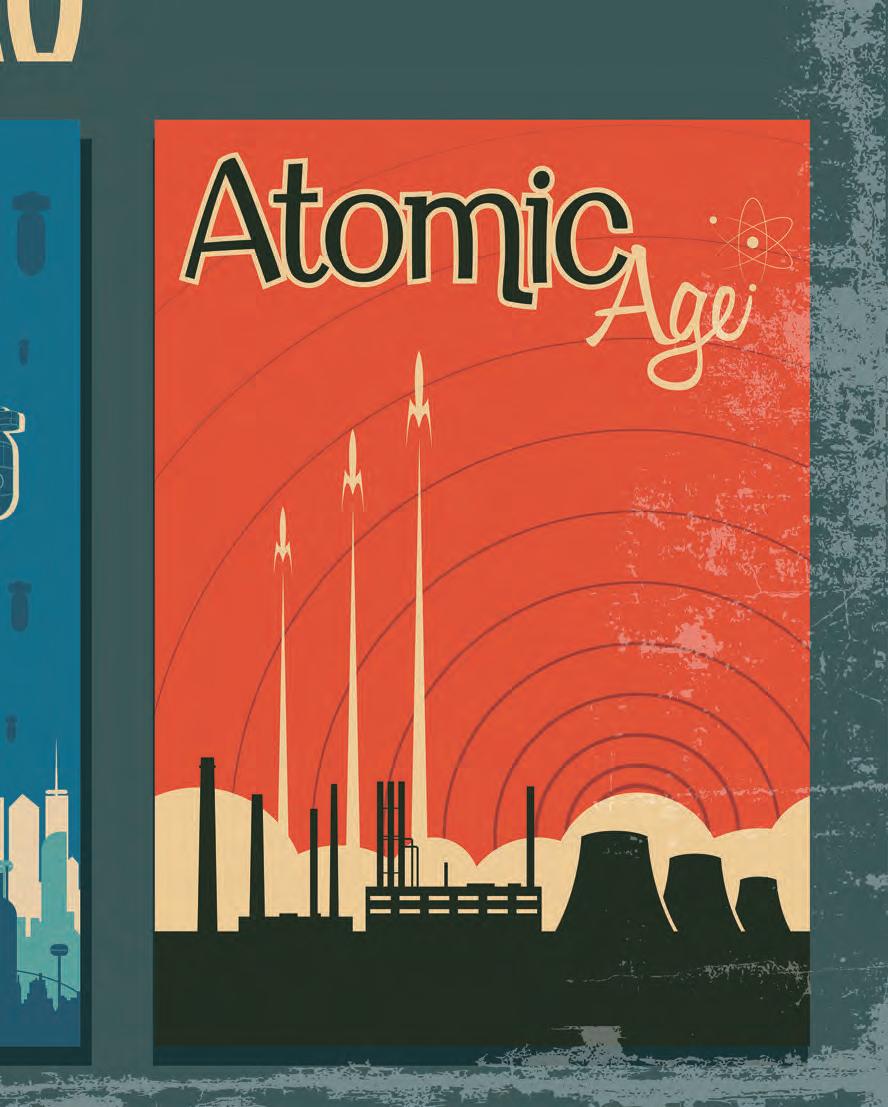
The field of nuclear energy is abuzz with, as Buongiorno noted, micro reactors and small modular reactors, or SMRs. The two, while both considerably smaller than a traditional nuclear reactor, have different outputs. “Recently I have seen … less than 20 MW is [a] micro reactor, above 20 MW is a SMR,” explains Buongiorno. Put another way, an SMR could power a city, while a micro reactor could power a large factory or a community.
“You crank [micro reactors] out of a factory a little bit like you would do with cars,” he says, citing his own excitement at the prospect, then you “load them on the back of a truck, and … you get to a site, and that’s your power plant.” These micro reactors would be portable, requiring no onsite construction (which could reduce or eliminate the cost overruns and schedule delays that plague larger nuclear projects), power can be built up in smaller increments, which would reduce capital
risk, and, he says, many projects don’t need the energy output of larger reactors. There’s considerable excitement around these micro-reactors, including right here on the Vineyard.
Norman Foster, an architect focused on high-tech, and a key figure in the modernist movement, who lives part-time on the Vineyard, has been working with Buongiorno. Foster believes we’re moving toward a revolution in nuclear power. “Imagine a 20-foot-long container housing a micro reactor, which when attached to a similar-size generator, could power a small town, or be plugged in to energize a city block,” he described to Bluedot Living in an email. “Another module could convert seawater to jet fuel, and the process would help to deacidify the oceans. Similar units could desalinize seawater.”
These smaller, sealed units, he wrote, would be safe and maintenance-free. The fuel module would be replaced every five to seven years, and the uranium fuel is non-weapons-grade.

SMRs are also on the horizon, the design product of NuScale, an Oregon-based company, with a $300 million investment from the U.S. Department of Energy. SMRs can be also built more quickly and cheaply than traditional nuclear plants, although costs are significant compared with renewable energy sources, and even natural gas. While no SMRs are yet constructed, several are close to completion in Argentina, China, and Russia, according to a Scientific American story, and many more are under consideration around the world.
As always, with nuclear energy, the two as-yet-unresolved issues are nuclear waste disposal and safety. The 2021 UCS report notes that even with considerable interest in nuclear energy, growth has stagnated due, in part, to a chilling effect from the 2011 accident in Fukushima, Japan. It cites the current rate of construction of new nuclear plants around the world as
only barely outpacing the retirements of existing plants, such as Pilgrim. The report goes on to say that “nuclear reactors and their associated facilities for fuel production and waste handling are vulnerable to catastrophic accidents and sabotage, and they can be misused to produce materials for nuclear weapons.” UCS calls on the industry, policymakers, investors, and regulators to address these concerns fully before expanding any nuclear energy projects.
Dr. Ken Buesseler, senior scientist at the Woods Hole Oceanographic Institution (WHOI) and an expert in radioactivity in oceans, has seen the damage from the Fukushima Daiichi Nuclear Power Plant accident up close. “When things go wrong, they can go very wrong,” he says. And while the nuclear industry likes to point out that there have been fewer than a handful of accidents, Buesseler isn’t so comforted. “If you think of three reactors in Japan, [plus] Three Mile Island and Chernobyl, you can say, ‘Look, five reactors had fatal accidents and meltdowns over something on the order of 450 commercial reactors over time.’ But you know, five out of 450 … you wouldn’t fly a plane if the odds were that bad.” Of course, he says, lessons have been learned. For instance, it’s highly unlikely that a reactor will now be built in a tsunami-prone area. But climate change, he notes, is creating profound changes to the planet, including to sea level rise. A safe site today mightn’t be so safe down the road. “No energy is independent of its consequences,” he says.
To address these legitimate safety
concerns, says Chakraborty, “up-andcoming advanced reactor designs also feature significant safety features — for example, with smart systems that will turn themselves off if any measurements change unexpect edly, without waiting for human intervention.”
Still, says Buesseler, “we have a nuclear waste issue that we’ve never dealt with satisfactorily.” Take Pilgrim, for instance. “That nuclear waste is going to sit in storage pools essentially until forever, or until they come up with someplace where they can collect it and store it in a safer manner.”
He compares it to pro ducers of fossil fuels not caring about its byprod uct, carbon dioxide. And look where that’s got us.
But Chakraborty suggests that concerns about waste are overblown. All the spent fuel used in the U.S. over the past 60 years only takes up one football field, 10 yards deep, she says. She rais es another point, too: “Having a strong nuclear sector allows the U.S. to play a role in international rulemaking on how and which nuclear materials are developed.”
Last year, she says, 38 national security experts wrote to Congress to argue that maintaining U.S. nuclear expertise and exporting new, U.S.-developed nuclear technologies is crucial to nonproliferation and national security over the long term.

Further, those urging the development and adoption of micro reactors, such as

don’t have the luxury of ignoring nuclear’s potential, they say, because, with the escala tion in electric vehicles, as well as popula tion growth, and, of course, the deepening climate crisis, only nuclear energy can meet this demand quickly and cleanly.
Just do the math, urges Foster. “The current rate of carbon dioxide, the prin cipal greenhouse gas, being spewed into the atmosphere is 36 billion tons per year, over 20 percent of which is created by the production of energy,” he says. “The reality
Norman Foster believes we’re moving toward a revolution in nuclear power: “Imagine a 20-foot-long container housing a micro reactor, which when attached to a similarsize generator, could power a small town or be plugged in to energize a city block. Another module could convert seawater to jet fuel, and the process would help to deacidify the oceans. Similar units could desalinize seawater.”
is that … only 2.1 percent of the world’s electricity is produced by solar, which is weather- and battery-dependent. Perhaps more strikingly, the world is dependent on fossil fuels for around 64 percent of its electricity needs — with all the knock-on effects of atmospheric pollution.”
Foster goes further to make a moral argument. “Societies which are deprived of [energy] suffer higher rates of infant mortality, lower life expectancy, less sexual and political freedom, and are more likely to be experiencing war or violence,” he says.
It’s fission — the splitting of larger atoms — that produces the nuclear energy we use now. But there’s growing excitement about fusion, which produces massive amounts of energy by doing the opposite — combining smaller atoms to create large ones. It’s
lasts for many thousands of years. What’s more, there is no chance of a meltdown.
Of course, where there’s promise, there’s investment, and some heavy hitters, including Jeff Bezos, are putting their money behind some fusion projects.
“For the first time in decades, there are serious breakthroughs that might make commercial fusion possible … in fewer than 15 years,” says Buongiorno. Fusion is similar to fission in many positive ways, he says. It’s carbon-free, dispatchable, has a low footprint, produces even less waste than fission, there’s broad availability of fuel (water), and, he says, “the physics of fusion eliminate certain safety concerns of fission, such as runaway reaction [like what happened at Chernobyl] and decay heat.”

Even with so much innovation and investment in nuclear energy, it’s a tough sell. Vineyarder Jorie Graham has made understand the potential of this coming generation of nuclear reactors. As a poet, she recognizes the power of language, and thinks that part of the problem with nuclear energy is public perception. Indeed, a doctor recommending an MRI barely
NMRI, for nuclear magnetic resonance cause of its negative connotations). But
the thoughts of many of us straight to meltdown. Graham is not alone in thinking nuclear energy suffers from a messaging problem, which is why, increasingly, we’re hearing references to “quantum reactors.”
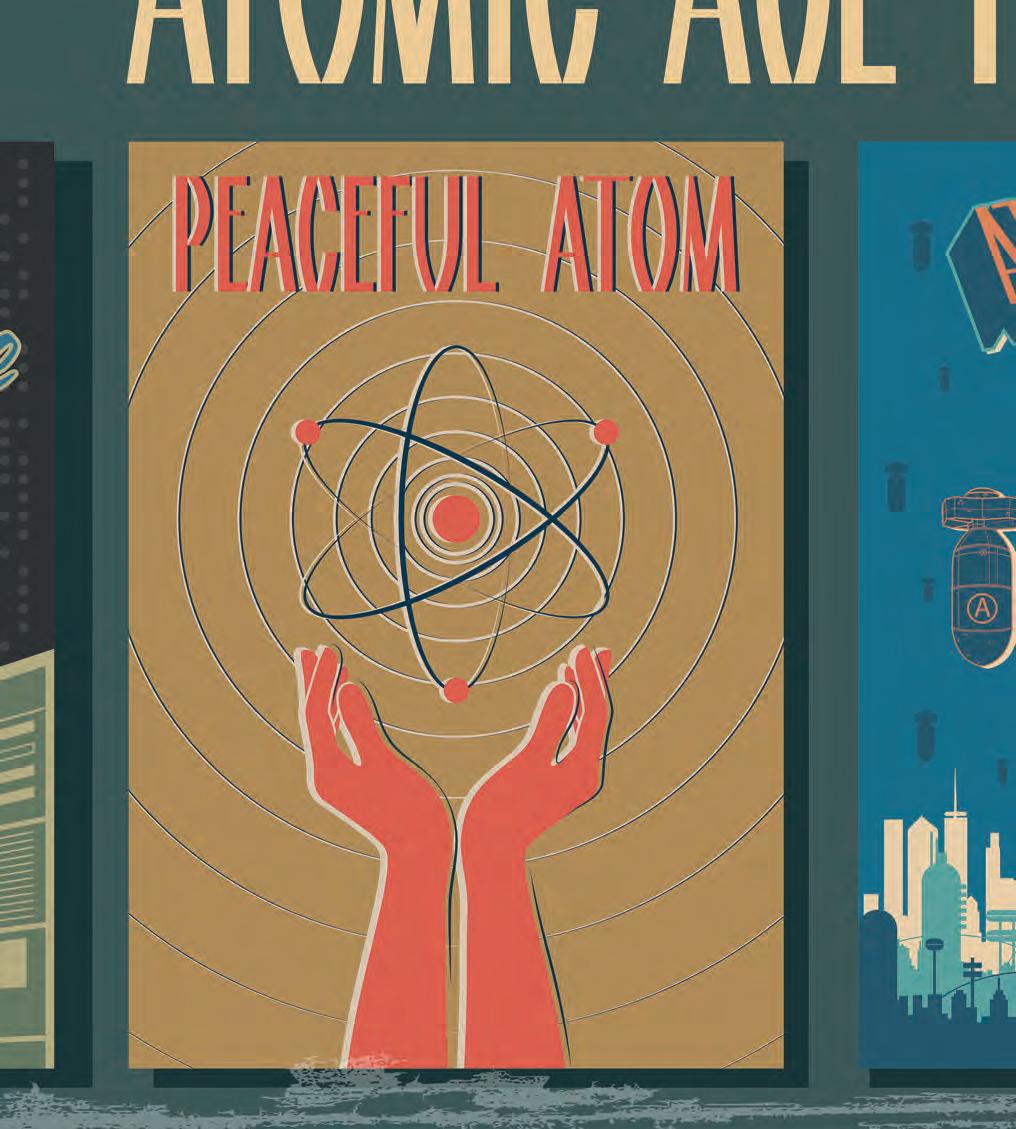
Whether security and safety concerns are warranted — and
— “nuclear is bad, but climate change is worse,” she says — there’s far too much opposition to it in the Northeast, though it’s a different picture in various other parts of the country. In New England, “It’s not a conversation worth spending time on,” she says. “I can tell you that the chances of getting [nuclear] sited in Massachusetts are close to zero.” Rather, she thinks the focus should remain, primarily, on wind energy. “I would say there’s no way in New England to address a clean energy future without offshore wind.”
“There is no such thing as perfect technology,” says MIT’s Buongiorno. Renewable energy, which has a whole lot going for it, nonetheless can’t offer a constant and predictable supply of energy. And, while battery storage is improving in terms of capacity and cost, “the system becomes so large and so interconnected that it requires big transmission lines,” which boost cost and vulnerability should the lines become severed due to weather, or terrorism. And Buongiorno points to the vast land use required by renewable energy.
not — nuclear needs to be taken off the table in New England, she says. Whileporter of nuclear energy
With discussion of pros and cons feeling like a game of nuclear football, perhaps wwhe folks at Project Drawdown, which analyzed and compiled the top 100 solutions to climate change, put it most clearly, calling it one of the only “regrets” solutions they proposed. “Nuclear is a regrets solution,” they write, “and regrets have already occurred at Chernobyl, Three Mile Island, Rocky Flats, Kyshtym, Browns Ferry, Idaho Falls, Mihama, Lucens, Fukushima Daiichi, Tokaimura, Marcoule, Windscale, Bohunice, and Church Rock. Regrets include tritium releases, abandoned uranium mines, mine tailings pollution, spent nuclear waste disposal, illicit plutonium trafficking, thefts of fissile material, destruction of aquatic organisms sucked into cooling systems, and the need to heavily guard nuclear waste for hundreds of thousands of years.” Nonetheless, they conclude, it is, indeed, a solution. ”
IIt was a foggy summer morning when I drove up-Island; the fog became denser the farther I drove into Aquinnah. Although I've known Native Plant Associates founder Carlos Montoya for 15 years, I had never paid a visit to his home garden. He warned me over the phone that things were a bit of a mess — his son Josh was in the midst of building his home on the property. When I first moved to the Vineyard, it felt like every time I drove a new dirt road I was in a different state, and it definitely felt that way the moment I began driving on the dirt road into Montoya's 13-acre homestead.

Although mostly a New Yorker growing up, Carlos went to school in Madrid in 1952, and when his family moved back to New York, he loved visiting his mother's family’s Long Island home. At the time, the town of Wainscott was still mostly potato farms. Carlos first saw Moshup Trail in 1971 on a visit to his sisterin-law, who had just moved to the Island. He says the south-facing shore of Long Island has the same plants and feel as Moshup Trail. Growing up, he liked to prune plants and “keep certain areas clear” when visiting Wainscott. As much as plants were of interest to Carlos then (he says he declared that he wanted to be a forest ranger in 10th grade), he explains, “my mother's father was a diplomat, and that's what they wanted me to be. So I was on a track to join the Foreign Service.” Although Carlos studied for four years, and admits that he “wasn't too bad at it,” he said it wasn’t for him. He says he still keeps up on foreign affairs.
After that first visit to Moshup Trail, Carlos knew he wanted to live there. Following a separation from his first wife,
losing his Vermont home (along with other life losses), Carlos moved to the Vineyard in 1982 and started over. He'd been working for the New York Times News Service, but upon arriving here, the Vineyard Gazette had no jobs, so he decided he would find a way to specialize in the native plants and grasses he loved. Through a friend's recommendation, Carlos started working for Nick Freydberg to create a little pond from the stream running beside the Freydbergs’ Chilmark home. Freydberg was the head of the investors for the Oyster Watcha Midlands project in Edgartown. Carlos tears up when he relates how Nick was there for him at the lowest point in his life. The two men are so different, but became close friends.
The first investor on the Oyster Watcha site to build a house turned to Nick, who recommended Carlos, and the rest is history. Carlos’ passion was to preserve the fields, the meadows, the grasses and indigenous plants — he feels so fortunate to work with those who share this passion, first Nick and then others. In those early days, Carlos had no truck, so he hired Trip Barnes, who used a 1948 converted school bus to go to Sylvan Nursery in Westport to get the plants for his first job. It was all a “bit haphazard,” he says. He says he and Trippy were “like Abbott and Costello,” but things gradually got more professional after that.
For his business, Pitch Pine Nursery, which he operated for 12 years in West Tisbury, he was a full-service design contractor doing ornamental work.
Carlos wanted to know more about sandplains grasslands, the ecosystem native to much of Martha’s Vineyard. He
also in bloom during my visit.
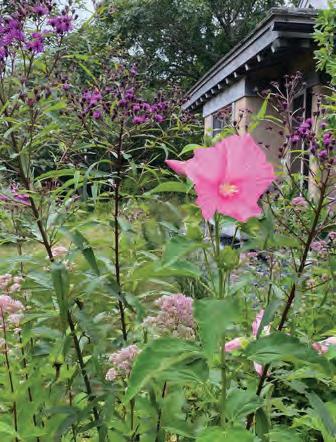

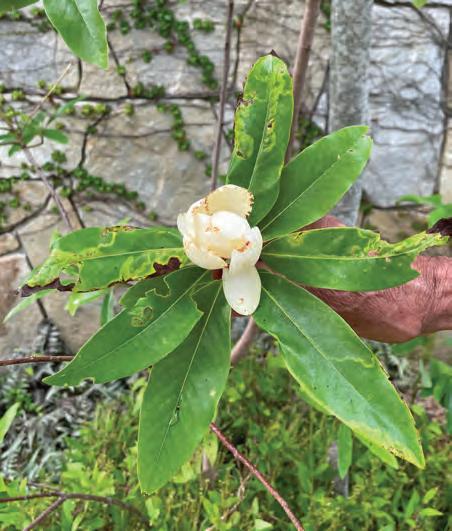
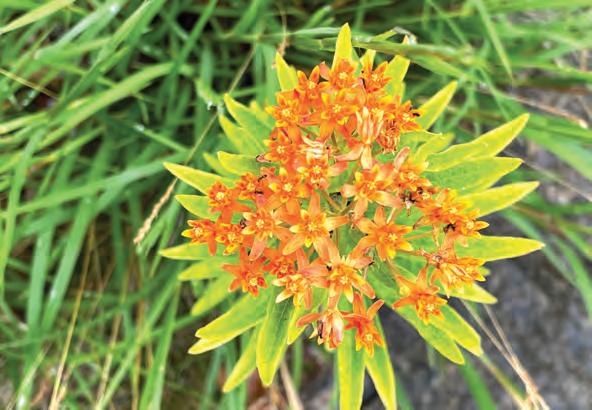

5.
6.
known as


began to study, but it was mostly on his own — there isn't much formal education on the topic. In fact, Carlos explains, sandplains grasslands are globally rare and “only exist on Martha's Vineyard, Nantucket, Cape Cod, and Eastern Long Island, where I grew up. They were geologically all connected, and grew apart.” Early on in his new career, Carlos says, he was always trying to mix native plants with the ornamentals.
During his time running Pitch Pine, he got Lyme disease, which forced him to take a two-year hiatus as he recovered. When he returned to work, he focused exclusively on sandplain grasses.
Before moving to Moshup Trail, he lived in rentals, and never had a garden of his own. Though he purchased his land in 1995, his Japaneseand Southwest-influenced home was not completed until 1999. There are a number of larger rocks around Carlos's home that came from digging out the foundation. Mostly Carlos manages nature around his home, not adding much. There is a small area planted with ferns around his front patio, then nature takes over. Carlos planted ferns because of the shade, explaining that it’s hard to revegetate around a house that has mostly shade.
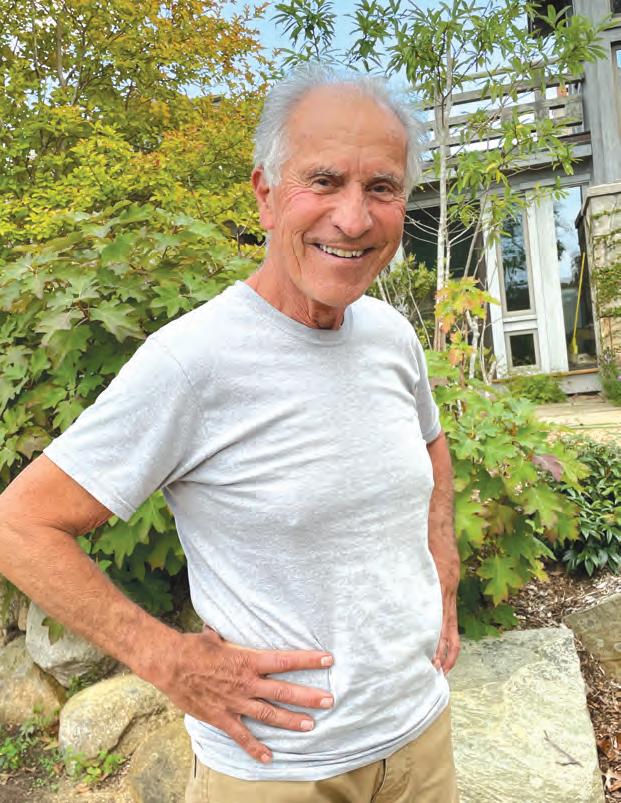
Carlos has a wide
variety of native plants (to see the extent of what he has, see the photos on page 29). There are dwarf conifers that he trims back. There's Lysimachia, a genus with over 150 species from summer-flowering to evergreen perennials, according to Fine Gardening. There are volunteer iris, native Joe Pye weed (which can grow to six feet in the sun), boneset (a wetland native), sweet woodruff (a shade-loving ground cover). There’s lowbush blueberry, huckleberry, a stiff aster, lilies Carlos planted. Looking around, Carlos says that he probably planted just four out of everything we saw, and then they repopulated. “This is my favorite of all plants — little bluestem is the core grass of a sandplain grassland,” he explains. Most common in Midwest prairies, it’s also known as beard grass, and according to wildflower.org, is one of the East’s most important native prairie grasses. When I wonder what his family's Long Island place was like, he tells me his parents’ meadow was a “little bluestem meadow with a little bit of sheep fescue,” often used in erosion control. We pass a New England blazing star, a native coastal species that is “virtually pest-free, disease-free, and deer-resistant,” according to gardenia.net. Another of his “absolute favorites
Our native grasses, Carlos explains, are warm-weather grasses that don’t need to be mowed down.Carlos Montoya standing in front of his Moshup Trail home.
is bearberry.” Nearby is the prettiest butterfly weed I’ve ever seen. Carlos harvested rose mallow seed along Moshup Trail, then created plugs that he planted. “A plug is a grown plant that is only five inches deep and two-and-a-half inches wide,” he tells me. To Carlos’s complete surprise, after renting and rototilling an area where the new road runs to his son Josh’s home, still a work in progress, the whole area is sprouting knotweed, and Carlos is still trying to figure out how it survived. There are volunteer asters before we move onto a grassy area. “That’s mainly sedge, a native,” Carlos says, “rescued from a job on Chappy so it wouldn’t be thrown out. You have to hatchet it into plugs; you can't seed it. Once hatcheted, you can plant it, much like a hair transplant. You put a little sheep fescue in between, since it’s a natural companion.”
Carlos has not retired, but he is only doing native plants and native
meadow work. It’s exactly what he wants to be doing. Our native grasses, Carlos explains, are warm-weather grasses that don’t need to be mowed down. Carlos says his website describes it best: "What we do is sandplain restoration, and that’s all we do.”
With that, we've made a full circle around his home, stand on the new driveway, and look out to a pond I learn was once likely “a depression left over from peat harvesting days, of which there was a good bit in Aquinnah in the 19th century, when it was dried and used as fuel.” Carlos shared his deep passion for nature, keeping companion native species sharing growing areas. The landscaping I visited was subtle with deep textures. Visiting Carlos in his element where every detail has both his and nature’s imprint was a welcome delight.
Learn more about what Carlos Montoya is up to at nativeplantassociates. com/sandplaingrassland-community/.



Imagine several hundred homes in this place. Imagine no more sweeping views across the sandplain to the sea.


To preserve an 128-acre ecological gem, it took a man who loved planes more than money.
Icaught Mike Creato on a good day. Good day for me, but not so good for Creato. That’s because Mike Creato co-owns Classic Aviators, which takes people up for biplane rides from Katama Airfield, and because the weather was looking iffy — fog was creeping in over the dunes of South Beach — he wouldn’t be giving any rides that day. And I would have a chance to talk to him about the Katama Airfield, which his family has had ties to for generations. I specifically wanted to know about how this little gem of an airfield, carved out of some of the most expensive and desirable real estate on the East Coast, hadn’t been snatched up by developers years ago.
We sat down at Creato’s desk in a wooden hanger that housed a 1940 Waco UPF-7 biplane. This fire-engine red aircraft sat staunchly on a cement floor behind Creato’s desk, surrounded by all forms of spare parts and paraphernalia, and hanging on a wall in back of the plane was a large rack of moose antlers and an old poster of Winston Churchill proclaiming “Victory.” I felt like Eddie Rickenbacker was about to walk into the hangar at any minute.
Creato told me the improbable story
of how this little grass airfield by the sea came to exist in the first place. Today it’s the largest grass airfield in the country. Formerly pastureland, it was established in 1924 (making it one of the most enduring grass fields in the country), and used by the Curtiss-Wright Flying Service, one of the first flying schools in the nation, and later by the Martha’s Vineyard Flying Club, among others.

In a personal journal kept by Steve Gentle, Creato’s grandfather, Gentle wrote, “Many well-known aviators put their wheels down at Katama — Roscoe Turner, Howard Hughes, and Max Conrad — and there is some evidence that the Spirit of St. Louis was photographed at Katama.” In another entry Gentle wrote, “Many people still remember the air meet that was held in 1928, and was attended by around 10,000 people.”
Steve Gentle made his name as a masterful flight instructor, giving lessons to people at the airfield pretty much from day one. But when the stock market crashed, things got pretty quiet. Creato remembers his grandfather telling him that in the ’30s, a man came out from Florida every summer in a biplane and put on an airshow.
“The way he got things started,” Creato said, “he would throw a chicken out of the airplane as he flew by, and whichever local kid caught the chicken, got a free ride — there were no rules back in those days.”
The airfield was closed during WWII; the Navy used it for target practice, and had a rocket range and a gunnery range there. Then in 1944, Steve Gentle bought the airfield — the day before the Hurricane of 1944, which left pieces of the hanger scattered all over the field.
Gentle wrote in his journal, “The corrugated sheet metal was strewn all over the area, with the hanger doors blown across Herring Creek Road and into the pines.”
With no hangar and no electricity, Gentle was nonetheless undaunted, and reconstructed the hangar. From then on, he and his family had a hand in running it continuously until 1985. The story of the airfield is interesting enough, in and of itself, but even more fascinating is the story of the land upon which the airfield rests.
The area around the airfield is known as the Katama Plains, a remnant of the Great Plains that once covered much of the Vineyard’s south shore.
Naturalist and MV Times “Wild
Conservation groups were interested in preserving the flora and fauna, and realized that their interests were aligned, ironically, with the peoplePhoto by David Welch
Side” columnist Matt Pelikan wrote in an email, “Katama Air Park is one of the best examples of coastal sandplain grassland/ heathland anywhere in the world. The airfield preserves populations of specialized plants and insects that are adapted to storm winds, salt spray, and periodic fire. Even by the Vineyard’s high standards, Katama is an ecological gem.”
Creato takes me through a little of the geological history of the plains. He explains that it’s basically a washout from the glaciers. “Sometimes I’ll get to fly around with a geologist,” Creato says, “and they’ll tell me stories about how the Island was formed.”
Apparently, when the glacier rolled across the Island, it stopped near the north shore, piling up boulders and debris almost a mile high. When the ice melted, there were no boulders left anywhere to the south, just sand; and that’s what contributed to the forming of the plains.
“What gets me even more,” Creato says, “is that this was all dry land after the glaciers melted and reced-
ed. There was no seawater between the Cape and the Vineyard until about 5,000 years ago, and the ocean was 30 miles off South Beach back then, out by the edge of where the continental shelf is.”
With the airfield back up and running after the war, and many aviators returning to the Island, Gentle felt he had found his true calling. He ran a charter business and gave flight instruction, and his wife Dorothy ran the snack bar. While no one was getting rich, at least Gentle was doing what he loved most in the world.
“My grandmother would say,” Creato
recalled, “‘You have a year where you’re starting to get ahead, then one of the airplanes would need a new engine, and there would go your whole profit for the next two years.’ Then somewhere in the early ’60s my grandmother said, ‘You know, real estate is starting to take off; why not get a real estate license?’ They hung out a shingle, ran an ad in the paper, and after 30 days sold four houses, more money than they had made in the previous 10 years.”
With real estate giving Gentle a financial cushion, he stepped back from the airfield and leased out the operations to others. “People would come in and run it for a few years and see if they could make money,” Creato said. “Although I doubt many of them did.”
It was during this period that the airport came onto the radar for two special interest groups in particular — real estate developers and conservation groups. Conservation groups were interested in preserving the flora and fauna, and realized that their interests were aligned, ironically, with the people at the airfield.
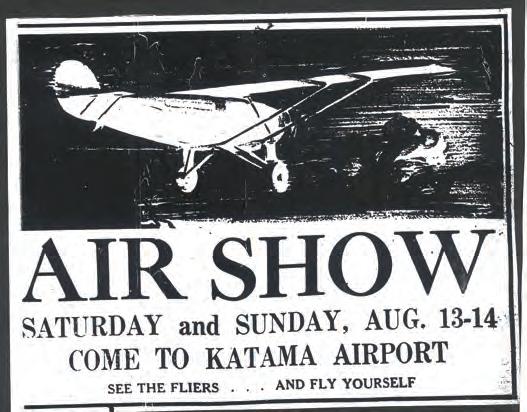

at the airfield. They were both interested in managing the property, and the conservation people appreciated that the airfield maintained the land.Katama Airfield is one of the oldest grass fields in the country. Poster courtesy of M.V. Museum.
They were both interested in managing the property, and the conservation people appreciated that the airfield maintained the land.

Without the airport clearing and burning back the brush, the pastures would be carpeted in forests, much like it is today elsewhere on the Island. Creato says that he’s seen old aerial shots from the ’30s showing that from Squibnocket to Menensha, there was all pastureland, while today it’s mostly trees and houses.
In the ’70s Gentle made it known that he was interested in selling the airfield (to be run as an airfield), and he was approached by developers who were willing to pay him a fortune to buy the land. With quarter-acre zoning in Edgartown at the time, the 128-acre field could have potentially resulted in 120 units of housing. “My grandfather wouldn’t even entertain that idea for any amount of money,” Creato said, “because he would lose the airport and everything it stood for.”

Creato, just a young man at the time, suggested that rather than selling the airport, his grandfather could develop the 12 waterfront lots and sell them for three times more than he could get for the whole airport.

“Nope,” his grandfather insisted, “I’m not going to do it.”
But in 1979, the town of Edgartown formed an alliance with The Nature Conservancy and the state that would
prove to be the best of all possible worlds. In 1983, Edgartown, backed by a bond from The Nature Conservancy and a grant from the state, would offer to buy the airfield and operate it in the future. This would keep developers from potentially building 120 units of housing on the land. The town would hire a manager for the field, and lease it out to tenants in the future. And T
he Nature Conservancy would oversee the cutting and burning between the runways. The town offered Gentle $1.5 million for the purchase of the 128-acre tract. The deal was somewhat complicated because Gentle had leased some parcels of land to several small farmers, and had to spend about $700,000 getting the property through land court. That left
“Katama Air Park is one of the best examples of coastal sandplain grassland/heathland anywhere in the world. The airfield preserves populations of specialized plants and insects that are adapted to storm winds, salt spray, and periodic fire. Even by the Vineyard’s high standards, Katama is an ecological gem.”
–Matt Pelikan
“When you see Katama from the air, the only thing that’s left of what Katama used to look like is this swath of open field where the airfield is — everywhere else is houses and pine trees.”
–Mike CreatoMike Creato pilots the red biplane for Classic Aviators. His grandfather, Steve Gentle, helped preserve the land. Photos this page by Alison Shaw.
Gentle with around $800,000, a pittance compared to what he might have made had he sold it off to developers.
But as Mike Creato said, “It wasn’t all about the money; my grandfather added $800,000 to his retirement, so he knew he’d be OK, and he knew the airfield would live on in the future.” In 1986 the deal was finalized, and was the cause of much celebration. It was one of those deals where everyone — except the developers — seems to have come out ahead.
“When you see Katama from the air,” Creato said, “The only thing that’s left of what Katama used to look like is this swath of open field where the airfield is — everywhere else is houses and pine trees. I think everyone is pretty glad it’s here, environmentalists, aviators, and families who just love to sit outside and have breakfast at the diner and watch biplanes take off and land. And all because Steve Gentle liked airplanes more than money.”
Hanging on the wall in a hangar at the Katama Airfield, up by the moose antlers, is a piece of a P-15 Mustang WWII fighter plane, “the best-looking piece of metal you’ve ever seen,” Mike Creato said. In June of 1975,
people up for rides all day Saturday, but at the end of the day he said he was tired and would come back the next day. Creato, who was just 14 at the time, asked his grandfather if he could get a ride when he came back.
the Oxford Warbird Club, a group of military airplane enthusiasts, decided to come to the Katama Airfield and put on an airshow — and they were bringing the iconic P-15 Mustang.
“Everyone who saw the plane was captivated,” Creato said, “The pilot was a WWII veteran, and flew it like he’d been flying it all his life.” The pilot took
But the next day, another pilot, John Crumlish, was there to take the Saturday pilot’s place. “He was a good-looking guy in his thirties,” Creato said, “and he looked like what I thought a German fighter pilot might look like.”
Creato saw his grandfather talking to the new pilot and
made eye contact with him, but his grandfather looked at Creato and shook his head ‘no.’
“I was ripped,” Creato said, “I thought he was being too conservative.”
His grandfather later explained that the new pilot was too new; he had only had about six hours flying the Mustang. And his grandfather proved to be right.

“Apparently the plane is not terribly hard to fly,” Creato said, “but there are about six things you just can’t do.” And not being fully familiar with the P-15, the pilot did something terribly wrong. He stalled while performing aerobatics, and he desperately tried to power out of the fall, but rudderless, the plane came hurtling down and crashed just feet from the administration building at the airfield. Crumlish was killed, but somehow no one else was injured, and no fire broke out.
It was a horrific day, but Creato learned an important life lesson — to never again question his grandfather’s judgment.
My husband Chris spent the early days of the pandemic picking up trash along Barnes Road. Most days he filled one or two large garbage bags with empty nip bottles, crushed soda cans, beer bottles, construction debris, car parts, and candy wrappers. People driving by sometimes yelled to him out their car window: “Thank you!” and “Bless you.” He also got hecklers: “I see they let you out on garbage duty.”
For the purposes of this piece, let’s define litter as an unwanted item that is improperly disposed of and let’s define a litterer as the person who is responsible for the improper disposal. Penalties for littering in Massachusetts include the possibility of a fine that can range from $25 to $15,000, arrest and imprisonment, and driver’s license suspension. According to the National Conference of State Legislatures, “The most common types of litter are food packaging, bottles, cans, plastic bags, paper, and tobacco products.”
toss their masks, their cigarettes, their soda cans, their nips and napkins and bagged dog dung into our woods? The MV Times polled people in their daily newsletter, The Minute, to try to find out. Apparently litterers don’t answer surveys, or at least don’t answer truthfully. Almost all of the 320 respondents claimed to never litter. A small sampling revealed they littered “A few times when I couldn’t avoid it” or they littered “accidentally.”
I started to wonder if littering might be a compulsive behavior, a kind of psychiatric disorder. Maybe litterers can’t help themselves. Are litterers like klep-
needs. I am entitled to do what I want.” He went on to explain, “At the root of narcissism for some people there is often the reality of having been abused or mistreated as children and a later sense of anger and the feeling that the world owes me and so I am entitled to defile it.”
Silberstein also suggested that litterers may suffer from poor impulse control. “Think about the condoms, needles, cigarette butts, and nip bottles that litter the parks and woods. The people who have left those behind are just not thinking about littering at all, they are consumed with getting their highs,” he explained.
The word “litterbug” was coined in 1947. The campaign against littering gained traction throughout the 1950s and 60s and on April 22, 1970, twenty million Americans took to the streets for the first Earth Day. Since then, there have been anti-litter ad campaigns that have moved us to tears — If you’re of a certain age you remember — “People start pollution and people can stop it.” And yes, we know, “Give a Hoot — Don’t Pollute.”
So why the hell do people still litter? Why are our roads and beaches scarred with discarded debris? Who are the litterers amongst us? Why do some people
tomaniacs, but instead of surreptitiously stealing they defile their surroundings with their waste and trash?
I asked two psychiatrists with Vineyard ties if they had ever treated a patient with a compulsive littering habit. “No,” they both told me, shooting down my theory. Littering isn’t a psychiatric disorder, nor is it a compulsion, but there are psychological reasons that some people may be more inclined to litter than others.
Dr. Charles Silberstein, a psychiatrist who practices on the Island, explained that people who litter may exhibit narcissistic tendencies. “A litterer may think, I am a special person and my needs are more important than other people’s
Dr. Peter Kramer, psychiatrist and bestselling author of “Listening to Prozac,” agreed that littering can be a sign of narcissistic and entitled behavior by people who don’t want to be told what to do. He added that “some people are inclined to feel guilty about littering — or even to feel compelled to pick up other people’s litter — while others are resolutely unconflicted.” Kramer also pointed out that “some people are just not not well put together, and they seem to leave a trail of objects as they go along.”
Following our conversation, Kramer sent me an article published in the popular British magazine The Spectator with the headline “My obsession with litter is bordering on mental illness.”
“Whenever I leave my house, I make a point of taking a plastic bag with me so I can pick up litter,” writes Toby Young.
“Why do I care so much about this? No doubt there’s a smidgeon of mental illness involved. It’s probably a variant of obsessive-compulsive disorder — litter rage.”
Writing in The New Yorker last spring, Bill McKibben contemplated whether there was much of a difference between the
personal litterer and corporate polluters. Tossing an empty soda can out the window is one thing, but companies (multi-national or not) polluting rivers is another. Citing the psychoanalyst and author Sally Weintrobe, McKibben noted that our culture is one of entitlement writ large: “The self-assured neoliberal imagination has increasingly revealed itself to be not equipped to deal with problems it causes,” Weintrobe wrote in her recently published book, “Psychological Roots of the Climate Crisis.” It is the young people, says McKibben, with their appropriate sense of entitlement who are “demanding we start cleaning up after ourselves.”
“ What kind of thinking goes into adopting a … strategy to protect a business model as you wreck the climate system?” McKibben asked about the tactics currently deployed by the Exxons of the world. Perhaps the psychology behind the can tosser and the corporate polluter really aren’t that different.
Organized efforts to clean up Vineyard beaches began in 1992 when Bob Woodruff rallied a group of students from the high school to comb and clean the beaches. The following year, Vineyard Conservation Society took over the beach cleanup, which remains an annual April occurrence.
“We find a lot of plastics, food wrappers, styrofoam, cigarette butts, nips, cups and lids, fishing and lobster gear, strings and balloons,” said Signe Benjamin, VCS’s membership and events coordinator. “Eighty percent of beach
trash is local in origin,” she says, which means that most of our local litter is not a “washashore” thing, it is coming from us. Benjamin has noticed a decline in the amount of refuse collected in recent years during beach clean up days, which she attributes to the growing number of people on the Island who pick up trash on a daily basis while they’re out for a walk.
Paul Doherty is one of the Island’s conscientious litter-pickers. “This all
environmental one, and we need to have substance abuse experts involved to get it resolved.” She added, “I feel like from cradle to grave, nip bottles are produced to be thrown out your car window.”
“You keep asking yourself, where’s it coming from?” asked Steve Bernier during a recent phone interview. For years the well-respected owner of Cronigs had a Sunday morning ritual of picking up litter off the side of the road. (He has been temporarily sidelined by health issues, but says he can’t wait to get back to it.) “We have an abundance of open pickup trucks and I think the stuff that’s coming out of the back of pickup trucks is three fourths of the problem,” Bernier said, “The weekends when we’re moving our trash to the landfill, we’re causing a lot of trash.”
started for me while walking my two dogs throughout different parts of the Island, just to mix it up for them. I started seeing nip bottles along the roadways,” explained Doherty, who along with a few other litter-pickers, is not shy about posting a photo of his haul of nip bottles he collected from the side of a road, usually not too far from a liquor store. “The nip bottle issue is a two-fold problem, the first being drinking while driving and the second, littering [the] fragile ecosystem of this Island,” laments Doherty.
VCS’s Benjamin also noted that the nip bottles on the side of the road aren’t just about litter. “It’s a social issue, not just an

Could it be that the majority of litter along the Island’s roadways is a result of people ineffectively securing their rubbish while they are on their way to the dump? If so, it seems like this somewhat passive-aggressive approach to littering (my analysis, not the psychiatrists’) should be relatively easy to remedy. Maybe we can start there.
“Let’s care about our Island,” pleads Bernier. For years, one Sunday after another people would honk and yell out “Thank you” and “Good morning, Steve” while he picked up the remnants of what he appropriately termed “a disposable society, full of single-serve everything.”
“Screw that,” said Bernier. ”Don’t say good morning to me. Pull over on the side of the road. Grab a bag and jump in and help.”
Kramer also pointed out that “some people are just not well put together, and they seem to leave a trail of objects as they go along.”
Sylvie Farrington is celebrating her 25th year of making all styles and sizes of bags from repurposed, vintage barkcloth. Barkcloth is a soft, thick, slightly textured fabric that was a popular choice in the 1940 to ’60s for drapery and upholstery projects. You’ve no doubt seen examples of the designs in old movies, or may even remember it from the curtains of your childhood. The heavy-duty fabrics come in fun, colorful patterns that truly exemplify the aesthetic of the midcentury modern home.
Farrington first fell in love with the look and feel of barkcloth when she found some of the fabric at an antique show in 1999. “The designs have such appeal,” she says. “They evoke a feeling of joy. They never really go out of style because they’re old to begin with. There’s a timelessness, and a sense of nostalgia.”
Each SylvieBag is handmade using authentic vintage barkcloth, sometimes pieced together with other heavy-duty cotton fabrics. Designs often incorporate hand-sewn Czech crystals for
punctuation, and fun, rainbow-colored zippers sourced from a company in Switzerland.
Farrington comments on the durability of the fabric, saying, “It’s a sturdy cotton weave. They don’t make cloth like that anymore.” She adds that the colors don’t fade over time, or bleed when hand-washed. Her latest creation, a large, rugged tote, can even be thrown into the washer and dryer.
The designer sources her material from a variety of places, although she says that it’s getting harder and harder to find.
“People who sell me the fabric say they wouldn’t know what to do with it,” Farrington says. “It’s nice to know that I have an entire business based on something that was made a long time ago and that is getting revived into a brand-new item. ”
The SylvieBag line includes pillows and potholders. Find all of the products at sylviebags.com. A selection of Farrington’s barkcloth pillows are also available at North Water Street Gallery in Edgartown.
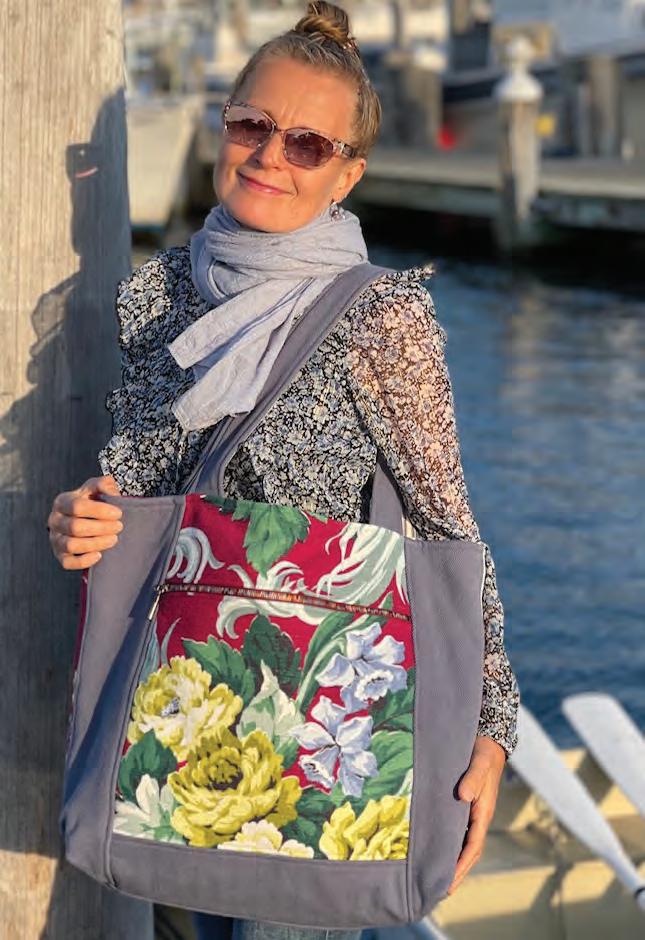
Beldan Radcliffe loves textiles. A fiber artist, printmaker, and collage artist, Radcliffe began stretching her artistic boundaries just over a decade ago when she was inspired by the colors, textures, and patterns found in castoff clothing. Using thrift store finds, she started deconstructing secondhand sweaters and repurposing the knits to create colorful, collaged garments.
“It’s kind of like picking a palette,” says Radcliffe of her design process. “The same way that a painter would put together a palette, I look at the sweaters I have and pick the colors I think are going to work together.”
The resulting designs are unique and eye-catching, featuring wools and quality cottons and synthetics in coordinating colors with swaths of patterns here and there. You might see a bit of an argyle or Fair Isle knit blended into the design, or maybe even a fun stripe or floral weave. The garment’s structures themselves are always interesting. Edges
are ruffled, cardigans often button up at the top, flaring out at the bottom for a skirt effect. Some pieces have roomy hoods made from layered colors. The upcycled sweater line also includes comfy collaged shawls, great for cooler weather. Each piece is one-of-a-kind, made from washed and preshrunk quality fabrics.

More recently, Radcliffe started making quilts and fun, bohemian skirts from repurposed T shirts and other all-cotton items. Her secondhand finds include patterns from butterflies and flowers to ethnic prints.
Radcliffe sees her efforts as a win-win. “I’ve always been interested in environmental issues and recycling, and not wasting anything,” she says. “I’m giving something another life — something that might have wound up in the landfill. And when I buy at the thrift store, the money goes back to charity. I’m supporting myself and helping others at the same time.”
Beldan Radcliffe designs can be found at the Night Heron Gallery in Vineyard Haven, and at the M.V. Artisans Festival. You can also purchase her
upcycled sweaters and artworks through her website, beldankradcliffe.com.
When life gives you unworkable soil, try farming salt. That’s exactly what Curtis and Heidi Feldman did when the small plot of land they purchased in 2001 with the thought of growing crops turned
out to be useless clay atop limited soil. Undaunted, the two decided to stick with their dreams of leaving their mainland lives and establishing a farm on the Vineyard. Heidi realized that there was no local sea salt on the Island, so she and Curtis looked to the ocean for their “crop” source. In 2013, the Feldmans revived the centuries-old Vineyard tradition of farming salt when they launched their line, Martha’s Vineyard Sea Salt.
Harvesting and preparing sea salt for consumption isn’t easy. Curtis and Heidi must gather thousands of gallons of saltwater; filter out any sand, seaweed, and other organic matter, evaporate the water and leave the remaining sea salt to dry over time in a huge solar greenhouse-type structure; pile it into mounds for further evaporation; and then carefully gather the crystals for packaging. It’s a time-consuming, tedious process, but one that yields the purest product possible.
“We don’t add chlorine bleach, or drying or anti-caking agents,” Feldman says. “All of those things are considered quote, unquote, ‘safe,’ as per regulations. We want you to be able to taste the salt.”
Along with the natural flavor of salt, the Feldmans also create blends to combine the natural flavor of their salt with other complementary ingredients. Nine unique blends are available, including lemon verbena and dill; sumac, paprika, and garlic; local smoked oak; turmeric,
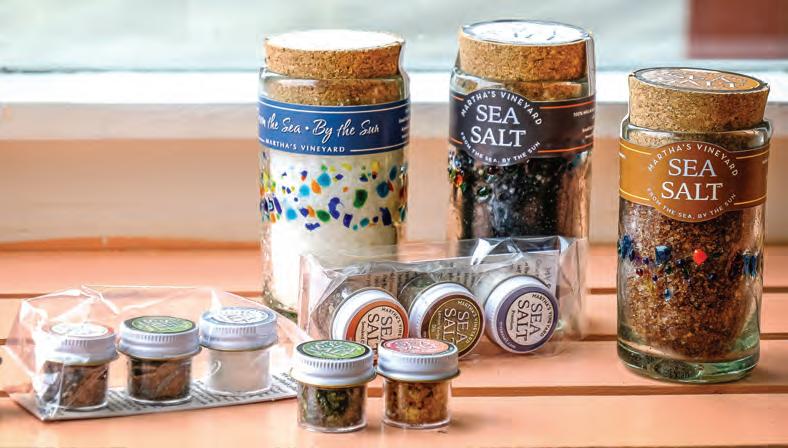
cranberry, and white pepper; blueberry honey; herbes de Provence; porcini; and something they call “Naughty” — a blend of sea salt and activated charcoal.
M.V. Sea Salt offers its products in three- or five-pack assortments, salt spritzers, 3.5-ounce hostess jars, and pretty 5.5-oz jars decorated with a ribbon of sea glass.
Whichever you choose, M.V. Sea Salt products make the perfect gift from the Vineyard. “We want people to experience the taste and the joy of the Vineyard,” Heidi says. “They can put that salt on their tongue, and they’re right back there on the Island.”
M.V. Sea Salt is available from various purveyors around the Island, or buy directly from the website: mvseasalt.com.
The famous Cliffs of Aquinnah (formerly Gay Head) are not the only place to find clay on the Vineyard. The Island is actually rich in clay, which is frequently dredged up
during construction projects. Local artisan Micah Thanhauser has taken advantage of that abundance of waste material — often using clay unearthed during construction in the work he creates for his business, Merry Farm Pottery. He notes that the excess clay would otherwise have to be carted off-Island for disposal.
“Martha’s Vineyard happens to have very diverse and interesting clays,” says
Thanhauser. “Nantucket doesn’t have any clay. Neither does most of the Cape.”
Thanhauser tries to keep the product as bare-bones as possible. He strains out pebbles and twigs, unless he is using the clay for a sculptural piece that might benefit from a rougher look: “My aim is to change it less and try to use more of a whole clay, without removing all of the impurities, and to find the beauty in that natural state.”
Thanhauser also sources some of his material from a North Carolina arts-centered community called STARworks, which describes itself as “the only ceramic supply company in the U.S. using local wild clays.”

The Island-born and -raised artist also mixes all of his own glazes, often using ash from his own wood stove.
This very organic approach to ceramics is reflected in Thanhauser’s simple designs, which are influenced by the time he spent studying in Japan. “The underlying philosophy in Japanese pottery is using materials that are unique to a region,” says Thanhauser. “Work is all designed around food and use. The main characteristic of Japanese ceramics is the emphasis on place and material.”
Merry Farm Pottery is located at 79 Merry Farm Road (off State Road) in West Tisbury. The studio and shop is open Thursdays, Fridays, and Saturdays from 11 to 5, or by appointment. You can also order online — shipping is available — at merryfarmpottery.com.
It was, of all things, a seat belt that inspired designer Stina Sayre to launch her line of women’s clothing and accessories. About 15 years ago, the Swedish-born former professional windsurfer had an idea for a bag design, but couldn’t find quite the right material for what she had in mind. The structure she was trying to create required a sturdy sort of flexible strip that could be wrapped into a spiral construction. Wide elastic proved to be too bouncy and stretchy. Not one to give up, Sayre noticed that the webbing used to make seatbelts possessed just the qualities she was seeking. She experi-
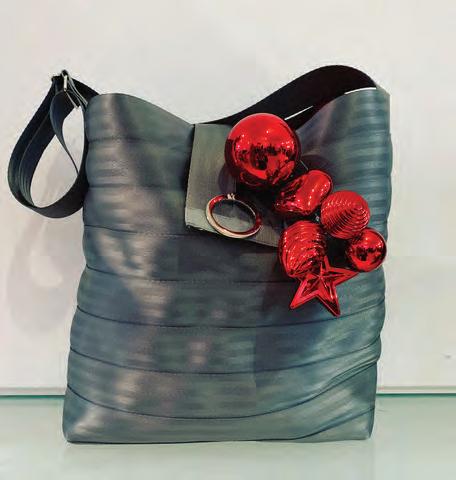
mented to get the design just right, and the bag was a huge hit right away.
Flash-forward a couple of decades, and Sayre has now successfully established her brand of contemporary but timeless European-style clothing made from quality textiles, and incorporating unique design features. Her line, which she sells at her Main Street, Vineyard Haven, boutique, as well as online, has earned her a loyal following and a reputation as a visionary designer. All of her dresses, coats, pants, tops, bags, and swimwear pieces are sewn by small manufacturers in Massachusetts.
“When you have something made overseas by a big manufacturer, you have to order very large lots,” Sayre says. “That way a wholesaler or retailer can push the price down, but they have to overproduce, and a lot of clothing ends up in landfills.”
Although she adds new items to her clothing and accessories line every year, the seat belt–based bags — available in a satchel, travel bag, and crossbody diagonal style — continue to be bestsellers. The material does not come from used items, per se. Sayre purchases the heavy-duty webbing in rolls, but it is still a reclaimed product that would otherwise be wasted, since manufacturers always have excess.
“I chose it because I really enjoy repurposing,” says Sayre. “I like the fact that I’m taking a material that is intended for car safety and making it into a bag.”
Stina Sayre boutique is located at 43B Main Street, Vineyard Haven. You can also shop online at stinasayre.com.
After years of working in custom cabinetry, Paul Farrington wanted to try something that involved working with wood in a more creative way. A few years back, Farrington, who runs the cabinetry shop for Holmes Hole Construction, started crafting one-of-a-kind pieces from wood reclaimed from felled trees or salvaged from construction projects around the Island. His coffee tables, end tables, chests, and mirrors all spotlight the various types of material he uses in its raw form, letting the beauty of the wood speak for itself.
Farrington creates his unique pieces
using a variety of styles of woodworking. Tabletops are crafted using live-edge pieces — thick slices that are left uncut at the edges so that they show the natural shape of the tree. He often uses actual tree stumps as bases. More engineered parts of his creations are carefully sawn to coax out the individual beauty of the wood grain, creating a rustic appeal.

“Working as a cabinetmaker for a high-end contractor, the designs are not mine,” Farrington says. “They’re all squared off, and white or off-white — more conventional. That doesn’t express the beauty and the wonder in the wood that I see from day to day. To me, even though the wood is no longer alive, it still has so much vitality. I want it to shine for itself.”
When Farrington first started sourcing wood from trees that had either fallen
down or were taken down for safety reasons, he was surprised at the interesting arboreal variety to be found on the Island. He uses wood from a number of different local species. “One of the things I really think is terrific is how some of these woods age. There are some really strong streaky colors and patterns from spalting [wood coloration caused by fungi]. I love the combination of colors and textures, and the way the wood grain presents flow.”
Farrington also sources antique wood from tear-down or renovation jobs, and even sometimes incorporates material that he salvaged from old ships during his days as a boatbuilder. “It’s all waste wood that would either go into a dump or a pit,” he says. “I love that I can give it a second life.” spiritoftreemv.com.

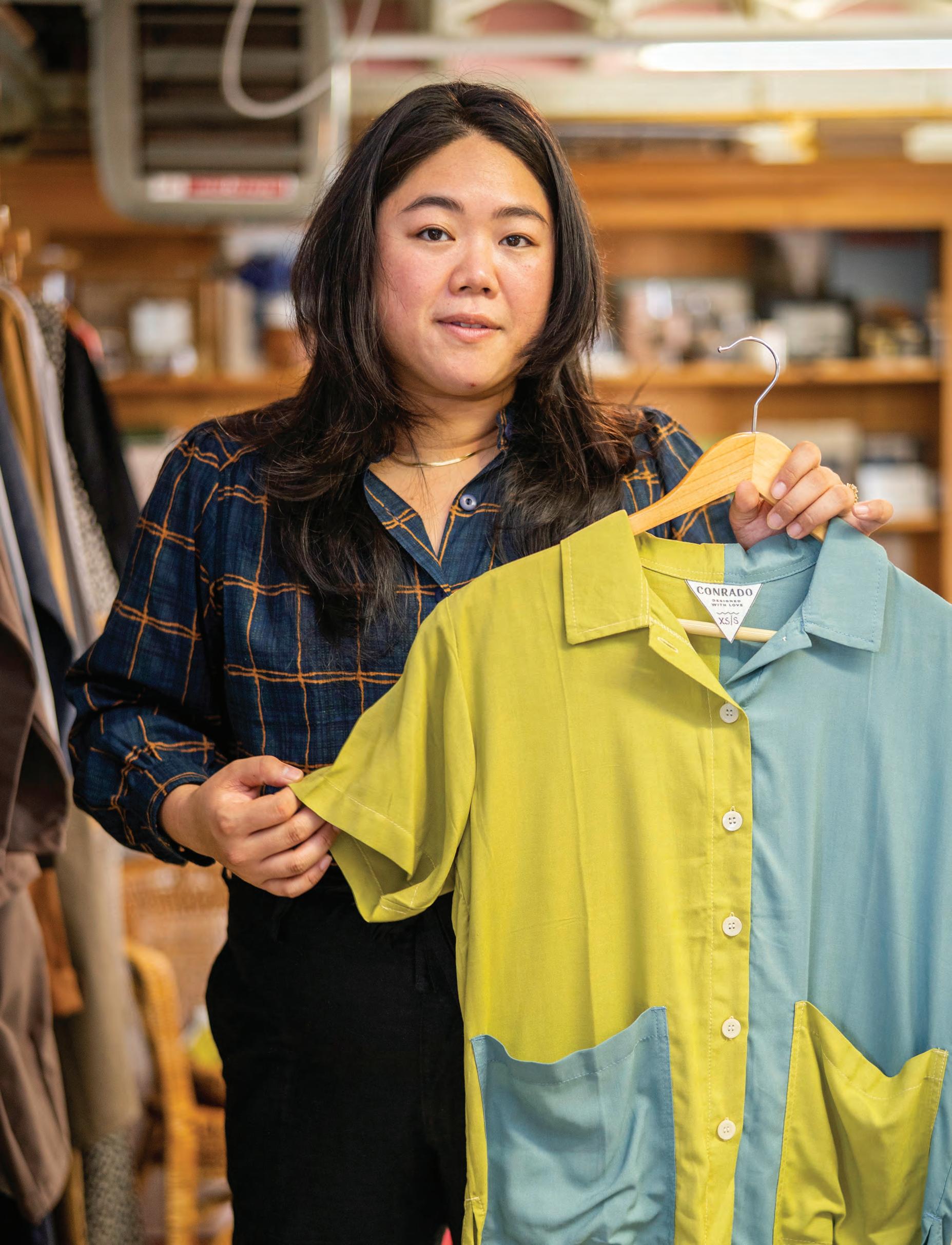 Story
by Leslie Garrett Photos by Jeremy Driesen
Story
by Leslie Garrett Photos by Jeremy Driesen
Angela Sison couldn’t have opened Conrado, her shop on Main Street in Vineyard Haven, at a worse time. There was a pandemic raging across the globe, and restrictions relegated many of us to our homes. Her stock largely consisted of dresses — and who wears a dress to watch Netflix or attend an online meeting? And then five other shops that carried her clothing closed their doors.
But Sison, who grew up in the Philippines watching her mother manage her garment factory, was undaunted. She created a few loungewear items better suited for pandemic life. She began making masks and donating them to hospital staff and other frontline workers. And people bought her items anyway, she said, suggesting that the pandemic reminded all of us that we needed to support our local businesses or risk losing them entirely.
But this isn’t just a story about small local businesses, it’s about ones built on sustainability. It’s about what, exactly, a green economy is. It’s about how we can grow an economy that treats both the planet and its people with dignity and respect.
Sison, for instance, makes her designs from what’s called deadstock in the garment business — the excess, unused fabric from a large contract that typically goes to waste. This summer, she’s hired two local students to help them learn the trade. She continues to use her mother’s factory in the Philippines, where


they ensure safe working conditions and fair pay. And while she loves fashion, Sison is committed to creating items that last, so that people can purchase less and wear them often.

What Sison is doing isn’t so much new as newly appreciated. What she is doing is participating in a green economy.
When we hear the term green economy, a lot of us think of solar panels and wind turbines, perhaps electric vehicles. And all of those innovations certainly fit. Indeed, two of the three fastest growing professions in the U.S. are solar and wind technicians (the third, for the record, is nursing).
Vineyard Wind, Massachusetts House Rep. Dylan Fernandes told Bluedot Living in a statement, is “a great opportunity to create new, well-paid jobs for Island residents.”
Liz Durkee, climate planner for the Martha’s Vineyard Commission, (and Bluedot’s “Local Hero” for this issue, see page 64) agrees that the wind farm jobs are a boon for the Island — early estimates are that roughly 500 union jobs will go to Cape Cod, New Bedford, and Martha’s Vineyard. “What is going to happen as we get more involved in climate adaptation and mitigation is more green jobs,” she says. But a green economy extends, she says, to “heat pump installations, electric vehicle maintenance, salt-marsh restoration, living shorelines.” The key is ensuring a workforce that’s educated in and trained for this growing economy, which is why an important part of Durkee’s work is in education. “We’re going to be talking more with representatives from the business community,” she says, “about things like going to the high school and
“GREEN ECONOMY,” BUT WHAT, EXACTLY, IS IT?Angela Sison’s Conrado studio is built on sustainability.
talking to the vocational ed people … so that students can have skills that are going to be marketable when they get out of high school.” Adult and Community Education (ACE MV) offers courses at various times, including wind technician.
Gina McCarthy, President Biden’s White House national climate advisor, calls it “a pivotal moment,” telling Grist CEO Brady Piñero Walkinshaw in a March 2021 interview that this is “an extraordinary opportunity to create a better life for our children… Not just about climate, but human beings who don’t live as well … because they’ve been facing systemic challenges for years.”
What McCarthy references is that a green economy can’t simply be about climate-related jobs per se; those jobs must be secure and pay a living wage. And more than that, a green economy must include climate justice — creating opportunity for those on the frontlines of climate change whose communities are or will be most affected. It’s about infrastructure that dovetails with climate goals. It’s about affordable, sustainable housing. Solar panels and wind turbines and EVs? Sure. But that’s just the beginning.
Liz Durkee is clear-eyed about the challenges that Martha’s Vineyard faces as the effects of the climate crisis hit close to home. “Change is coming, and we can’t stop it,” she says. “So we
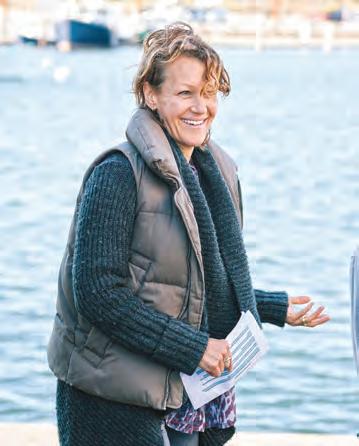
have to embrace it, and look at ways to improve the situation.”
Durkee considers a green economy as part of a larger Vineyard economy, which includes the blue economy — people working in the businesses related to the ocean and coasts, and the creative economy — artists of all kinds.
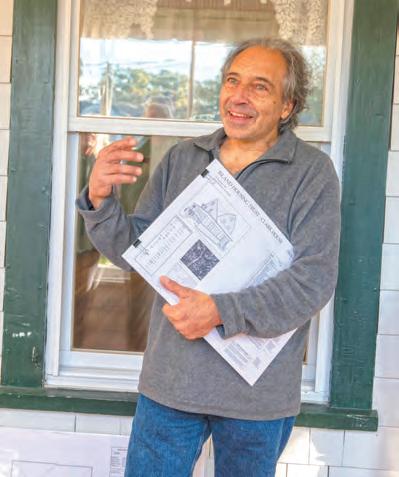
Nevette Previd, founder of Farm. Field. Sea., which organizes and promotes events related to the Island’s food culture, has given this considerable thought. “I worked on the Living Local harvest festival for years,” she says, “and we would try to sum up ‘living local,’ a snapshot of the Vineyard itself, a literal living local economy. You need affordable housing, you need a fair living wage, you need accessible food.” Previd sees the blue economy as separate from the green, but with a similar intention. “Blue economy is focusing on those who make their living on or from the sea. If we do it right, there’s a lot of opportunities for us as an Island to build up communities who are slowly, because of [climate] reasons, being compromised, like fishermen or oyster farmers, to give them more of a platform, more of a voice, to help them help themselves.”
To Derrill Bazzy, the purpose of a green economy is simple. “It’s people,” says the project development manager for Island Housing Trust. Putting those people in affordable housing is what Bazzy
Continued on page 58
“What is going to happen as we get more involved in climate adaptation and mitigation is more green jobs,” says M.V. Commission’s climate change planner, Liz Durkee, “including heat pump installations, electric vehicle maintenance, saltmarsh restoration, living shorelines.”Nevette Previd Derrill Bazzy ELIZABETH CECIL, (LEFT), LEXI PLINE, (RIGHT)
You’ve likely heard that the burning of fossil fuels is the single largest contributor to the warming planet. And chances are you also know that the situation is dire — the Intergovernmental Panel on Climate Change (IPCC) declared that the global carbon budget will be reached in the next 15 to 25 years if the world burns fossil fuels at its current pace of 50 billion tons per year. Adding to the sense of urgency is the economic power of the fossil fuel industry — which earned $2.1 trillion in revenue in 2021 — and has no plans to stop drilling. While the fossil fuel colossus might stand in the way of a green economy, a growing divestment movement has already begun to topple it.
Divestment is the removal of investments from the stocks of fossil fuel companies, and from bonds and funds that back them. By divesting, activists seek to apply economic pressure by depriving these companies of cash from investors. This sort of pressure can bring about social change by forcing companies to act differently. The fossil fuel divestment movement has made tremendous gains, with more than 1,300 institutions, with assets over $14.6 trillion, having committed to divest from fossil fuels to date. In the last few weeks alone, Harvard and Boston University have divested their endowments
of fossil fuel investments.
The most newsworthy targets of the divestment movement are institutions such as universities, religious organizations, and banks. But individual investors can also put pressure on the fossil fuel industry by divesting and reinvesting in renewable energy.
As with the economics of any other commodity, when demand for a stock decreases, that stock’s value also decreases. James Miller, a former economist at the EPA, says, socially responsible investing aims to make the stock price go down by making it less desirable for investors to invest in that company.
The moral argument for divestment is straightforward — financially supporting the oil and natural gas industries inhibits the transition to alternative energy sources.
There are financial reasons as well — and they’ve been gaining popularity.
Since an eventual transition to greener energy is inevitable, some economists believe fossil fuel investments could create a “carbon bubble,” leading to a global economic crisis.
Recent research has indicated that investors have a personal incentive to divest. A recent report by BlackRock, the world’s largest asset manager, claims that portfolios divested from fossil fuels actually saw greater returns than those not divested.
Despite many institutions being slow to divest in a market long driven by oil and gas, the divestment movement has prompted change by major actors. Student activists have persistently called on universities to divest — a recent victory was Harvard’s pledge to divest its $42 billion endowment from all fossil fuel holdings. Other major divestments include pledges from the World Council of Churches, the Rockefeller Brothers Fund, and New York City.
Green banks have cropped up across the U.S., offering an alternative to the nation’s largest banks, which are among the top investors in fossil fuel stocks. Organizations such as Climate Safe Pensions provide a network for pensions to commit to divestment. Environmentally responsible financial advising — a large component of socially responsible invest-
ing (SRI) — equips individual investors to finance their values. And activist movements such as 350.org, which establishes local chapters across the country, are rallying public pressure on institutions by spreading awareness of the urgent need to invest in clean energy.
Luke Murphy, managing director of financial services for Martha’s Vineyard Investment Advisors, a division at Martha’s Vineyard Bank, is one of the increasing number of investment advisors across the country expanding their environmentally responsible investing options. Murphy and his advising firm want to let people know that environmentally and socially responsible investing does not have to come at the sacrifice of financial performance — and clients are starting to catch on. “As far as trends go on the Island, we have had an increasing amount of requests from clients and prospects looking to invest in impactful and sustainable environmental, social, and community impact investments,” Murphy said.
As divestment activist and writer Bill McKibben puts it, “Money is the oxygen on which the fire of global warming burns.” Public values are shifting toward environmentally responsible investing, and fossil fuel giants are losing their oxygen supply.
- Lily Olsen“On the Island, we have [more] requests from clients looking to invest in impactful and sustainable environmental ... investments."
–Luke Murphy, MV Bank
 Story and Photos by Mollie Doyle
Story and Photos by Mollie Doyle
Even though I lived in New York City for more than a decade, had eaten food by some of the city’s best chefs, and edited many cookbooks by some of these chefs, I did not sincerely appreciate food until I was pregnant. In fact, it was food that told my now-husband Thomas and I that we were pregnant. We were at the International Documentary Filmfestival Amsterdam, and had just eaten a fantastic lunch of butternut squash soup and salad, when we walked by one of the city’s many shwarma shops, and I just turned in, ordered a chicken kebab, and inhaled it before Thomas could vocalize his shock. Until that moment, I had been oscillating between vegetarianism and veganism for years. A day later, I told him I wanted — no, needed — a burger. He suggested that we get a burger and a pregnancy test. Sure enough I was, as they say in Dutch, zwanger. For the nearly 10 months I was pregnant with our daughter, I felt like I was eating every food, every flavor, for the first time. It was amazing. I felt liberated. After years of being ridiculously careful about every piece of food I put in my mouth, I ate what I was craving. This included wheat, some meat and poultry, and cheese. Oh my god, cheese! And bread. I no longer cared what anyone had to say about gluten, bread was ... no, is ... a miracle.
A day or so after our daughter Emma was born, we left the hospital and went to my parents’ house. It was early August, and we were lucky that they were delighted to house two new, overwhelmed parents. I remember sitting down in a big white chair with Emma sleeping in my arms, and feeling the weight of parenthood descend. This incred ible creature was now out in the world, and it was my job to keep her alive. Could I do it? The terror came flying in. This was not haunted house terror, it was visceral, I-amdrowning-will-I-survive terror.
● Unlike many pans, cast iron is not coated in harmful toxic chemicals.
● A well-seasoned cast iron pan is as nonstick as any coated, nonstick pan .. .but again, no chemicals!
● Except by copper, the even heat distribution of a cast iron skillet is unparalleled.
● Cast iron skillets are a relative bargain. A Lodge 12-inch skillet is around $28, whereas an AllClad skillet is around $140, and an enameled cast iron 12-inch Le Creuset skillet is about $210.
● They are tremendously versatile. You can cook with cast iron on your stovetop — from sauces to poaching — and use it for grilling or baking in your oven.
At that moment, my mom walked into the room bearing a plate of warm Irish soda bread. I could smell the grated orange peel. I slathered a slice with salty butter and took a bite. The sweetness of the currents with the bite of citrus told me it was all going to be OK. I could do this. All that was ahead of me. Known and unknown.
So I share this recipe with you because it is one of those special memory foods for me. Because this Irish soda bread reminds me of food’s incredible power to soothe, heal, and inspire. Because it is delicious.

Great for a scared new parent, or anyone who loves yummy bread.
4 cups all-purpose flour, plus a tsp. for currants
3 Tbsp. sugar (or less)
1 tsp. baking soda
1½ tsp. kosher salt
4 Tbsp. butter, cut into cubes
1 egg
1¾ cups buttermilk (make sure you shake it!)
1 tsp. orange or lemon zest
1 cup dried currants
Kate Warner was at her high school graduation ceremony, just months shy of starting an environmental science track at Brown University, when her chemistry teacher pulled her aside and asked her to rethink the decision. It wasn’t that she didn’t have the grades. “You’re one of my best students,” Warner remembers the teacher saying, “but if I pour two liquids together, what a science student should say is, ‘What reaction is taking place?’ What you say, Kate, is, ‘What a pretty color!’”
Warner’s mathematical mind and her creative bent have long been in competition with one another, but she never saw any reason she couldn’t embrace both. She’s a self-described “overlapper” when it comes to careers and technologies, but there’s always been one constant: Warner has been speaking
out against climate change since the early ’90s, specifically as an advocate for solar energy on-Island. It wasn’t until fairly recently that the Island was willing to listen.
It turned out that Warner’s chemistry teacher was right. She dropped out of her environmental science program and pursued a degree in textiles from Rhode Island School of Design, then a degree in architecture from Columbia University. After working in the shadow of the New York skyline for a spell, she accepted an offer to work for a residential architect on Martha’s Vineyard, where she’d long spent summers.
Warner soon started working as an independent architect, but her schooling in environmental science weighed on her conscience. “I fell into a deep depression,” she said. “I felt like I hadn’t made the impact on the world I wanted to make.”
She read Al Gore’s Earth in the Balance, and after learning how electricity use and transportation contribute to climate change, began seeking ways to integrate sustainability into her architecture work.
The first experiment was ReCraft East, a demonstration house Warner constructed in Oak Bluffs, using recycled and sustainably sourced materials. It was inspired by Steve Loken’s ReCraft 90, a similar demonstration home in Missoula, Mont.
The second experiment involved changes to Warner’s own home, which she built in 1996. She installed the first grid-tied solar electricity system on Martha’s Vineyard, and began exploring early options for electric cars.
 STORY BY KELSEY PERRETT PHOTOS BY SAM MOORE
STORY BY KELSEY PERRETT PHOTOS BY SAM MOORE
The third experiment did not go over quite so well. Warner insisted that all of her architecture clients install solar arrays (on what was often their second or third home). Warner, in exchange, would offer her services at a discount. The follow-through rate for clients was poor.
“That turned out to be a mess,” Warner said, “and it pretty much ruined my architecture career.”
She was an early advocate for solar energy on Martha’s Vineyard, but it failed to catch on. Now that climate change is more pressing than ever, she’s ready to share her vision with the next generation.

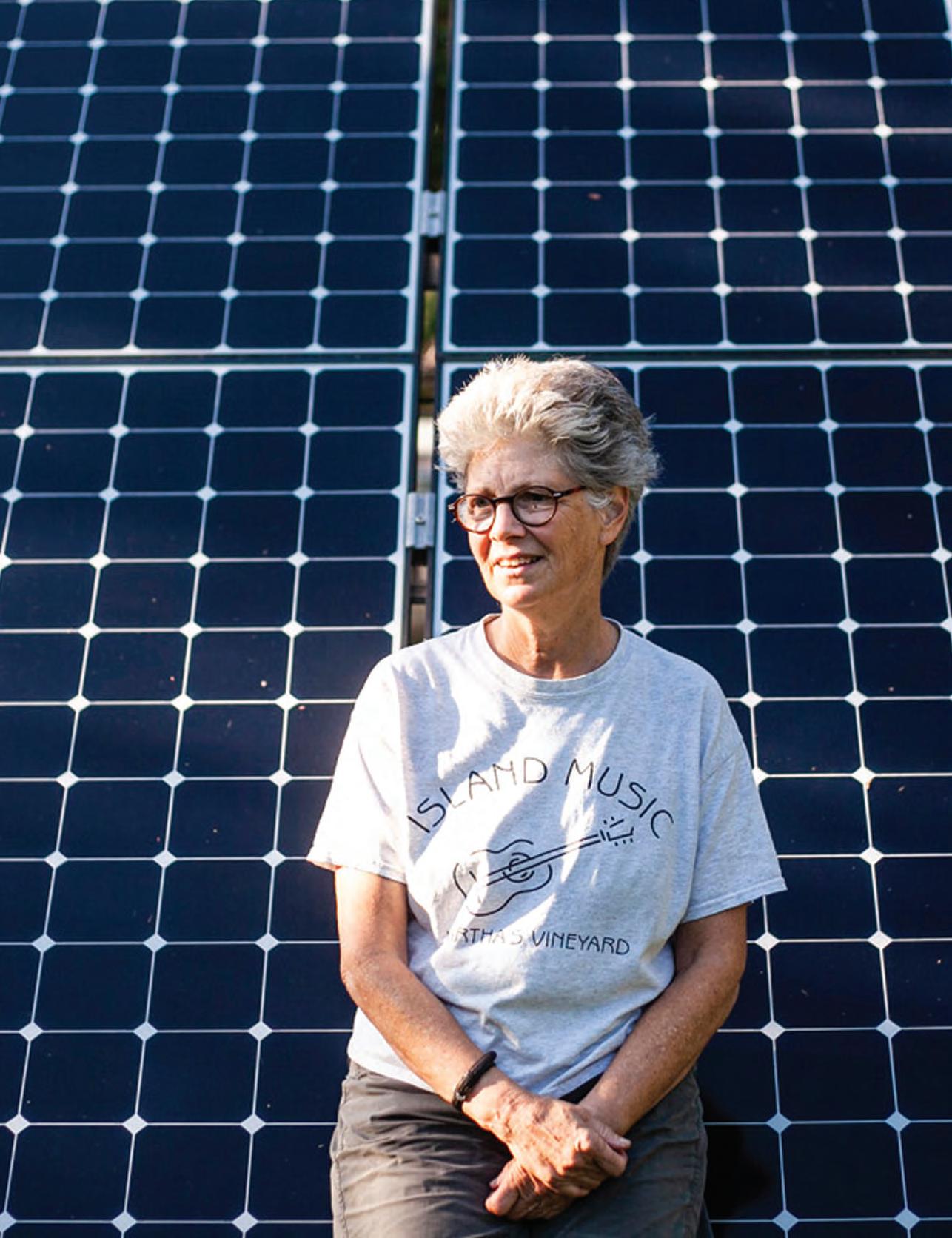
So Warner flung herself into a variety of other solar energy projects on the Island. She founded a business called Under the Sun, which would eventually evolve into initiatives like the Vineyard Energy Project and Vineyard Power. The group offered workshops for architects, plumbers, electricians, homeowners, and even schoolchildren to learn about energy efficiency. Warner also helped facilitate the Island’s adoption of the Million Solar Roofs project, a series of grants from the U.S. Department of Energy that led to the first 100 solar arrays on Martha’s Vineyard. Warner earned the “best solar progress” award for the initiative. Thanks in part to those arrays, 7.7 percent of electricity on Martha’s Vineyard is now generated by solar. Warner also orchestrated several solar demonstration sites around the Island — displays that still exist at Cronig’s, the Chilmark Community Center, the Aquinnah Cliffs, and the West Tisbury School, among other locations. Warner said she encountered a lot of mistrust surrounding solar, largely based on solar hot water systems that were improperly installed, poorly maintained, and ill-functioning. “When solar electric came along, people said,
Solar doesn’t work,” Warner said. “I was trying to get past those preconceptions.”
Warner was met with some interest, but even more resistance. “I did all this work, but I was a little bit before my time,” Warner said. “I was seen as a leader, but I was too intense. People did not want to connect with me. I was really leading this thing as part of a lone crusade, and I got burnt out. It was very lonely.”
It would be nearly 10 years before Warner was publicly
Warner’s own home is a modest abode approaching 25 years old. She modeled the 1,200-square-foot home after her ReCraft East experiment, and has been steadfastly updating her utilities as more efficient energy technologies emerge.


The first foray into solar was the hot water heater on Warner’s roof, which feeds a tank in the basement. In the winter, that heater boosts water from about 50° to anywhere between 80 and 100°s. In the summer, the temperatures reach closer to 150°. Warner is able to turn her
hot water heater off altogether between May and October. When she does use the hot water heater, it’s powered by an efficient heat pump that intakes air from the basement. That heat pump also works as a dehumidifier, which is great for combating mold and mildew in the humid Vineyard summers.
Warner added a solar array (in the form of a backyard panel) about a year after she moved in. She’s since expanded the array to about five kilowatts. This supplies all of the power for her property, and charges
her electric car. The sun shines on the panels to produce a direct current. That direct current runs
involved again in “anything to do with energy.” She focused her efforts on improving the energy efficiency of her own home and transportation. She also founded the Vineyard Bread Project, a weekly, community-supported bread program. Warner’s electric ovens are powered by her backyard solar arrays, and she finds the baking process to be a great use of her creative sensibilities as well as her mathematical skills: “It’s very precise; everything is weighed and done in a certain time frame,” Warner said. “On

Wednesdays, my brain has to put everything else aside and start weighing out the flour, and on Thursdays, all I can do is bake bread. It’s actually very meditative, a kind of zen to keep my mental state under control. I think it’s good for me.”
A few years back, on a whim, Warner attended a talk about climate change on the Island. “And now I’m back to my old tricks,” she said. She joined the nascent Island Climate Action Network. She chairs the West Tisbury energy committee and climate advisory committee. She serves on the M.V. Climate Action Task Force. In addition to helping her town lessen its climate impact and mitigate potential climate change impacts, Warner is involved in an effort to get local energy supplier Eversource to build up the Island’s renewable energy infrastructure.
The only difference is that this time around, Islanders are ready — not only to listen, but to do their part. “In those 10 years, younger people came along; climate change started to appear in the paper with greater regularity,” Warner said. “There are now tons of people involved in climate stuff. I can get feedback on what I do, and work
into the basement, where inverters change it into alternating current. If any of the appliances from Warner’s home call for power at that moment, the power is used immediately. If not, the power returns to the grid, and Warner is issued a
credit. Warner typically generates a surplus of power between March and November, then uses her credit toward the winter electric bills.
When Warner first built her home, the propane-fired baseboard system she installed was considered one of the most efficient heat sources on the market. While that system is still in place to add an extra off-season boost, Warner has since upgraded to a heat pump. The heat pump can create warm or cool air, then distribute that air through a mini-split in her living room.

Warner also leased an electric car, a Smart Car, for about $150 a month. The model has since been discontinued, so Warner is searching for a
replacement. She recently test-drove a Tesla in the automatic steering mode. “It scared the shit out of me,” she said. Warner does most of her driving on-Island, so she doesn’t need a lot of range, but she notes it’s nice to have a vehicle with enough clearance to take on the Quansoo road.
There are many ways to implement these new technologies, Warner stresses. In some cases, you don’t have to give up your existing car, your hot showers, or your beloved fireplace. “Anybody can do this; there are lots of ways to get into this arena without jumping off into a place where you don’t feel comfortable,” Warner said. “The important thing is to get going.”
with other like-minded people.”
Those people are equally excited to work with a pioneer like Warner. “Kate’s experience as one of the first advocates for renewable energy on the Vineyard was invaluable in the early work. Now she is a vital member of a strong team of Island volunteers moving us toward an all-electric future,” said Ben Robinson, chair of the Island Climate Action Network. “But more than that, I have personally valued her clarity, advice, and friendship on tackling the immense challenges of climate change.”
Go solar, or visit capelightcompact.org/clcgreen to be sure you are using clean, sustainable energy to power your needs
Save yourself money on maintenance, and cut out a big user of fossil fuels. Go to normalnow.com or drivegreen.greenenergyconsumers.org to find out what’s available.
Go with a cold-climate air source heat pump, and lessen your operating costs. Go to masssave.com and bit.ly/go-clean to learn more. Exchange your hot-water system for a hybrid electric water heater, enhancing summer dehumidification, and saving on your energy bills. bit.ly/go-clean
Learn the basics at this Island Climate Action Network link: bit. ly/ican-solar. Contact David Smith at dbssolarconsulting@hotmail. com to learn about many Vineyard solar installers.
Use a water bottle. Make a pledge
Not to say there aren’t moments of doubt in the face of an issue as ominous as climate change, but Warner tries to enjoy the little things. Or at least the moments where the little things overlap with the big issues. The warming scent of fresh cinnamon raisin bread. The taste of fresh-grown beans
to not buy single-use beverages that are in plastic containers.
To reduce plastic in your pantry, check out Mollie Doyle’s story on page 48. Make your own yogurt, so as to not buy plastic containers of yogurt each week.
Try a shampoo bar. Warner loves the rosemary lavender one from chagrinvalleysoap.com.
Get metal tiffins for your kid’s lunch. The Charter School has switched to these for all the food they serve.
Learn more at theworldcounts. com. When it comes to carbon dioxide emissions per passenger per distance, flying is second to none. Only do it when absolutely necessary.
They encourage mindless consumption and a throwaway culture. Use our libraries, Dumptique, and Chicken Alley to find the things you need. Or ask friends if you can borrow an item, instead of buying one for yourself.
Read about the companies you are investing in, and don't support any fossil fuel exploration, extraction, or combustion. See story in this issue on page 47 about divesting.
from her garden. Her electricity meter steadily spinning backward, thanks to her solar arrays.
Warner’s friends joke that her mood is directly attributable to how many kilowatt-hours she is generating. She doesn’t dispute that, she just shrugs. “Everybody is happier when the sun is shining,” she laughs.
“Um …,” let Kate
She also founded the Vineyard Bread Project, a weekly, communitysupported bread program. Warner’s electric ovens are powered by her backyard solar arrays, and she finds the baking process to be a great use of her creative sensibilities as well as her mathematical skills.
The rooms in our homes are ripe for change. The clothes in our closets, the products in our pantries, the bins in our basements. They might be made with less-than-planet-friendly materials, or come in packaging that will clog our landfills, and there just might be too, too, too much of everything. Where to start can feel overwhelming. Follow along as Mollie Doyle explores our shopping, living, and home habits, and leads us toward a healthier home — for both the people in it and the Earth it sits on.
I’ll be honest. I find all the pictures of people’s glossy, zero-waste kitchens with perfectly labeled Mason jars to be obnoxious, and, for the most part, dishonest. Do these folks really have not one piece of single-use plastic in their kitchens? Not even a plastic trash bag? I don’t believe it. I also don’t like the feelings of guilt and shame these photos tend to elicit.

So let me say this: If you have plastic in your pantry, or any climate-change-contributing product in your fridge or pantry, it is not entirely your fault.
Plastic food packaging is nearly inescapable. Want blueberries, but not in a plastic package? Good luck! Here on Martha’s Vineyard, if you want plastic-free blueberries, you can get them from your garden, farmer’s market, or a friend, for about a week a year. When I was a child, we bought our berries in green cardboard cartons. What happened? Well, it turns out there is big money to be made in putting your blueberries in a No. 1 plastic package. (Note: While No. 1 PET plastic can be recycled, the EPA reports only 29.1 percent is. At most local transfer stations. plastic fruit containers cannot be recycled.) According to the World Packaging Association, the revenue of the global packaging industry is more than $500 billion. That financial incentive is hard for the food industry — in every phase of operation — to work against. Though I have tried, I have not figured out how to entirely play the non-plastic game.
As far as I know, there is no short, easy answer to curbing your waste in the kitchen. Of course, COVID-19 has made it that much harder. Because of COVID-19, per the board of health, the use of bulk bins at Cronig’s and other markets has been suspended. So, other
than Eva Raposa’s MVY Food Co-op, there is no way for Vineyarders to purchase food such as oats, flour, rice, or nuts in bulk. If you decide to order these items, it is extremely challenging to find a place in the U.S. that ships bulk food without the use of plastic.
This all said, there are still things you can do to move toward having less plastic and less waste in your kitchen. And I will do my best here to inspire you to aspire to move in this direction.
As with everything, awareness and willingness are the first steps. Be honest with yourself about your willingness. Overreaching and making this strenuous for yourself and your family is not going to lead to success. Maybe, like me, you still want an occasional batch of fresh blueberries. Fine. It does not have to be, nor should it be, an all-or-nothing.
The easiest way to become clear about what you can and cannot give up is to assess your kitchen plastic habits. Open your fridge. Where do you see plastic? Do you buy mushrooms in a container with shrinkwrap? Do you put lemons in a plastic bag? Do you buy onions in plastic netting? You can make great strides with your plastic reduction in the produce aisle with relatively little effort. I generally put my fruits and vegetables directly into the cart — even my lettuce heads — because I am going to either peel or wash them anyway. And I put my herbs in a reusable mesh bag. Over time, this eliminates a ton of plastic.
Beyond the fruits and vegetables, what else is housed in plastic? Juices? Mustard jars? Cheese! I don’t know of any cheese that doesn’t have some kind of plastic in its packaging. As I’ve said, there are some things that are going to be hard to replace. But mustard in glass is an easy swap for mustard in plastic, and so much better for the planet, as glass can be reused and recycled.
Next, take the same trip through your pantry. How much is in plastic? Again, some of it is unavoidable. I cannot find crackers that don’t have some kind of plastic sleeve. When I did a deep dive on companies making zero-waste crackers, there were recipes, not brands. In other words, if you want zero-waste crackers in your kitchen, make ‘em.
Then, assess your can habit. Cans are
Drawdown, one of the world’s leading sources for climate change solutions, compares this to 37 million cars’ worth of greenhouse gases. So this whole notion of stocking up does not serve us — in any sense of the word. As my family can tell you, I am obsessive about keeping my fridge and pantry clean and organized. Even with a focused effort on not buying too much, I still find uneaten, spoiled food. Things that have helped us get better at wasting less:
· Shopping with a grocery list and sticking to it.
· Reflecting rather than reacting as we shop.
tricky. While they seem better, and may result in less plastic getting into our oceans, the production of one aluminum can release about twice as much carbon dioxide into the air as one plastic bottle. Yikes! Can the cans as much as you can.
As you are looking around your kitchen, ask yourself, Am I the kind of person who will wait in line to get meat from the butcher, to put either in a glass container or have them wrap it in paper, rather than the prepared meat wrapped in plastic in the case? Maybe the answer is some days yes, and some days no. That’s OK. You may discover that you get better meat and poultry when you do ask for it, and that encourages the habit change as well.
That is what all of this is about: habits. Maybe we buy a brand because our mothers did. Maybe we buy something because we like the box. I am guilty of buying stuff out of habit or curiosity — not necessarily because I need it or am going to use it, which leads me to the first of my seven simple rules:
According to the USDA, 40 percent of all food in the U.S. does not get eaten. Project
When you can, swap your products housed in plastic or aluminum for ones in glass or paper packaging — particularly with things where there are easy and delicious alternatives. These are easy wins. Sometimes the solutions to using less plastic are just yummier: Grey Barn bread in a paper bag vs. the store-bought bread in plastic. A no-brainer.
This does not mean buying in bulk, because that will lead to food waste (see Rule No 1). When it is possible again, we can all bring our glass jars to Cronig’s, weigh them, and fill them. Zero waste. Hopefully, other shops will follow this example, and follow suit. In the meantime, I am disappointed that so many of the small shops and farm stands here sell things like nuts, chocolate chips, and other products in plastic containers when paper bags are an easy and better alternative.
Every few months I give myself a goal. One challenge for us has been plastic bags. We stopped buying them, and I’m happy to
So let me say this: I f you have plastic in your pantry, or any climate-change-contributing product in your fridge or pantry, it is not entirely your fault.
tell you we are still alive. Yes, it is occasionally a pain in the butt, but we’ve found alternatives — Mason jars, silicone bags. Not using plastic bags continues to be our biggest challenge, as so much produce comes in prepackaged plastic bags. Pre-pandemic we could rebag our kale from Ghost Island’s plastic bags, but right now it’s not an option. So we reuse these bags.
Another irony of the zero-waste movement here in the U.S. is that while there is not a lot of attention to how the food is originally packaged, we have a zillion online stores selling us products to store our food once we have it — food huggers (they literally hug your food and serve as a cling wrap replacement), food stashers, beeswax wrap, Mason jars, silicone bowl lids, stainless steel boxes. All of these alternatives are worth investing in, if you will use them. In our house, Mason jars are a staple for holding everything from grated Parmesan to loose tea and sugar. While some are fans of the beeswax wrap, I find it tends to hold the smell of whatever food it is wrapped around. So I opt for silicone products, which don’t hold odors, and can tolerate super-hot water and soap many times over.
Continued from page 4
gift, especially those by Vineyard writers, purchased at our local bookstores.
Gwyn McAllister (“Buy Less, but Buy Better”) writes frequently for MVTimes publications.
Sam Moore (photographer, “Kate Warner”) is a writer and photographer who often works in conservation. His favorite local food item to bring to a holiday dinner: anything made with butternut squash!
Lily Olsen, intern (“Divestment”), is new to the Bluedot team — joining from sunny California. She is a recent
Compost first, then recycle, then and only then trash.
Have a compost pile, use a friend’s compost pile, bring your compost to Island Grown’s compost site, or compost in your town’s composting program. It’s easy, and makes a huge difference. According to Project Drawdown, “Nearly half of the solid waste produced globally is organic or biodegradable. Much of it ends up in landfills; there, it decomposes in the absence of oxygen and produces the greenhouse gas methane … Rather than generating methane, the composting process converts organic material into stable soil carbon, while retaining water and nutrients of the original waste matter. The result is carbon sequestration as well as production of a valuable fertilizer.” (See how Dear Dot describes the benefits of composting: bit.ly/ DOT-compost.) Composting and recycling will drastically minimize your trash output.
While I am not a fan of promoting products, nor do I think we can buy our way out of this climate change mess, I do believe
Princeton graduate with a degree in political science, and has worked in the realm of human rights — interning at the State Department and the AND Campaign. Her appreciation for nature and passion for human rights coalesce in combating climate change. She’s based in California, and she says she loves to give friends and family an assortment of products from the Santa Barbara farmers market: “My go-tos are infused olive oil, candles, and lavender sachets.”
Kelsey Perrett is a freelance writer, and the digital projects manager for Bluedot. “I used to stock up on NYSM (now Happyist) chocolates before I went off-Island just in case I needed a quick emergency gift. Or a boat snack,” she
there are three products worth investing in:
SodaStream — This product eliminates carbonated water bottles and cans, and it has pretty glass bottles to store your carbonated water in! The carbon dioxide cartridges are exchangeable and reusable.
Water filter — While we are blessed with incredible water here, if you have lots of iron or sediment in your well water (hard water), a water filter such as the Berkey is a wonderful tool, eliminating any need to purchase bottled water.
A coffee device that does not use coffee pods. Please ditch the pods! There are many incredible coffees out there, and so many coffee companies working to make coffee a more sustainable product. Please don’t involve your precious morning coffee with trash (see Dot’s advice, above).
I guess the other reason I have a problem with the pretty pictures of zero-waste kitchens is that they do not portray the reality of what it means to do the most difficult thing for us humans: Change. Change is messy, full of mistakes, uncomfortable. And that is ultimately what this zero-waste pantry effort is about: doing something hard now, so that it is a bit easier and better for all of us down the road.
tells us. “They’re made from sustainably grown, fair-trade chocolate, and the ingredients rarely interfere with dietary restrictions.”
Alison Shaw (photographer, “Katama Airfield”) is a gallery owner and photographer.
Valerie Sonnenthal (“Carlos Montoya”) is a frequent contributor to Times publications, and the Chilmark town columnist for The MVTimes.
Lucas Thors (“Local Hero”) is a reporter for The MVTimes.
David Welch (photographer, “Katama Airfield”) is a freelance photographer.
While the romantics among us might blanch at the notion of putting a price on, say, a sunset, or a snowcapped mountain, monetizing the natural world is likely as old as money itself.

Conservation is sometimes perceived as getting in the way of prospering off nature, rather than recognizing that the preserved natural world can dispense financial benefits that are hard to quantify. For instance, regenerating and protecting the mangroves of Colombia ensure the health of local fisheries, reduce the likelihood of flooding, and sequester so much carbon their existence helps the country get closer to its Paris climate agreement goals. While it might be noble to protect
nature for its own sake, for the awe it inspires, the Natural Capital Project at Stanford operates with the belief that environmental preservation is also to serve us. Not as radical as it sounds when one considers that we, too, are a species, though arguably an invasive one.
“Expressing some of
nature’s values in monetary terms can help make clearer what’s at stake from losing or degrading [it],” says Lisa Mandle, lead scientist with the Natural Capital Project, which aims to motivate people to preserve the natural world. She points to the time in the 1990s when New York City considered installing
a water filtration plant, but discovered it was cheaper to invest in upstream communities to conserve the Catskills watershed, which provided most of the city’s drinking water.
Putting an actual figure on the natural world isn’t saying that number reflects the full value, explains Mandle, noting that spiritual and cultural values assigned to the natural world aren’t quantifiable: “But by adding that additional monetary benefit to the calculation where it might otherwise have been assumed to be zero, we can show a more comprehensive picture of what’s at stake if we choose not to preserve nature.” Find out more at naturalcapitalproject.org.
does. But not just any housing. Sustainability is key to Bazzy and those involved with Island Housing Trust. Given incentives for nonprofits to build with an eye to environmental responsibility, it’s just as affordable, says Bazzy, “and [President] Biden’s promising even more in that direction.” Right now, Bazzy is working with Resonant Energy, a employee-owned certified B Corporation (a certification that requires adherence to social and environmental responsibility). Resonant Energy contracted with South Mountain to put solar on a project at Scott’s Grove in West Tisbury. But more installations are in the works. “We have a lot of rooftops,” he says. Beyond the positive impact on climate, solar panels mean lower utility bills. “Making it work for people to be able to stay [on the Vineyard] can also be regenerative for really good housing,” says Bazzy.
Continued from page 46
But while respect for the environment is vital to a green economy, Bazzy insists that people remain the cornerstone. “Most of us agree that conservation is a good thing,” he says. But “housing is people conservation. Why do land conservation if you’re not going to do people conservation?”
Gina McCarthy concurs, noting that “housing is a climate issue
too,” alongside good-paying, unionized jobs, transportation (hello, VTA’s electric buses!), green spaces, tree planting, and air quality …
“Food, too,” says Liz Durkee. “The more food we grow on our own, the more secure we are.” She points to the growing role aquaculture can play in an Island context: “We have to look at the big picture and see how it all relates together.”
Durkee sees a Vineyard economy through the lens of what’s possible. “What we can do is take these [climate] challenges and turn them into opportunities,” she says. “We can make things even, in some ways, better than they were before.”
Which is precisely how Angela Sison sees Conrado’s mission. When someone walks into her store, she says, she always talks to them about how her clothes are made. “And right away, I see a shift in their faces. They’re not just looking at pretty items … they have a story to them.”
Previd sums it up: “I guess the green economy is basically saying all humans should have the possibility to live the best that they can live.”
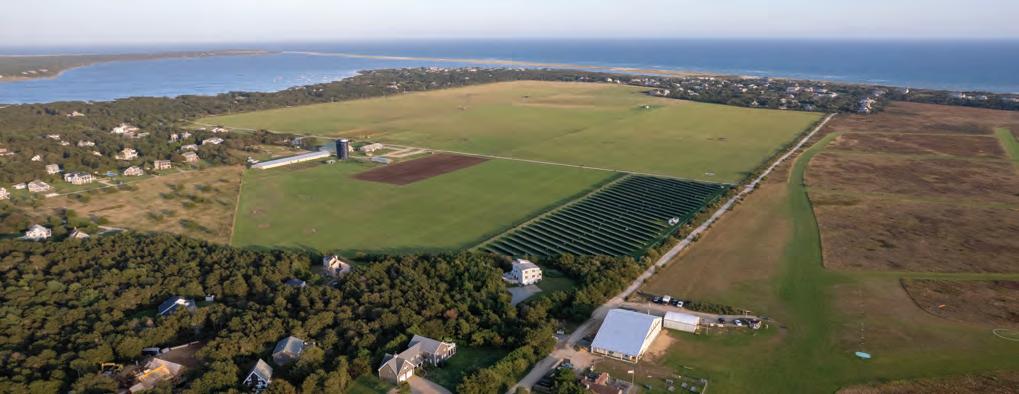


All six towns have the same rules for what can and can’t be recycled.
CAN
METAL CANS
• Primarily food and beverage cans
• Empty and clean wash
PLASTIC CONTAINERS
• Bottles, jars, jugs, and tubs
• Empty, wash clean
• NO caps or lids
GLASS CONTAINERS
• Bottles and jars
• Empty, wash clean
• NO caps or lids
• NO ceramics, NO window panes
PAPER AND PAPERBOARD
• Office paper, junk mail, newspaper, magazine, paperboard boxes
• Empty and flatten, NO shredded paper
• NO pizza boxes
• NO books with bindings
CORRUGATED CARDBOARD
• Empty and flatten
• Remove packing tape
• NO pizza boxes
• NO waxed boxes
• Recyclables in a garbage bag
• Garbage
• Plastic bags or plastic wrap
• Food or liquid
• Styrofoam items or packaging materials
• Clothing or linens
• Tanglers (hoses, wires, chains)
• Electronics
Aquinnah, Chilmark, Edgartown, West Tisbury
• Dual sorting system
• Cardboard and paper go together
• Plastic containers, tin cans, aluminum cans and glass go together
Oak Bluffs (local drop-off)
• Dual sorting system
• Cardboard, newspaper and paper go together
• Everything else single stream
Tisbury (local drop-off)
• Dual sorting system
• Cardboard and newspaper together
• Everything else single stream
Oak Bluffs Bruno’s Drop-Off
• Dual sorting system
• Separate cardboard
• Everything else single stream
Bruno’s and ABC’s Pick-Up
Recycling Rules:
• Single bin, don’t need to separate materials
• If you’re unsure about whether some thing is or is not recyclable, it’s better to throw it out. If recycling bins are contaminated with too many non-recyclable materials, the entire bin will be thrown out. “When in doubt, throw it out.”
ABC’s & Bruno’s
• No-waste policy: if there is any nonrecyclable material, bin is thrown out
MVRD
• Similar, but more materials-dependent. Food waste and oil contamination are more no-tolerance, whereas materials like plastic bags and styrofoam are more tolerated. The biggest mistake Don Hatch of MVRD sees:
• Putting plastic bags, plastic wrap or cellophane plastic in recycling
• All meat and fish (including bones, lobster shells and egg shells)
• All dairy
• Grains, nuts, seeds, flour products
• Fruits and vegetables
• Tea bags (staples removed)
• Coffee grounds and coffee filters
• All flowers
• Paper napkins and paper towels, unless they have toxic products that will not break down with high heat on them
UNACCEPTABLE ITEMS
• Large amounts of oyster, clam, little neck, mussel shells. Contact the Martha’s Vineyard Shellfish Group to recycle these!
• Fat/oil/grease Small amounts in the form of leftover prepared foods is fine
• Compostable serviceware
‘Keep-This’ Simple, Smart, Sustainable Handbook
Recycle, compost, volunteer, write your rep, buy secondhand. The
IGI piloting this in August
• Plastic or trash of any kind
• Compost buckets available for free at IGI’s offices in West Tisbury or at town transfer stations. To request a bucket, email office@igimv.org or call 508-687-9062
Drop-off locations (currently all free)
• Transfer stations in all towns except Aquinnah
• Chappy ferry dock
• IGI’s farm
Best way to reduce food waste is still to shop and cook mindfully, repurpose foods that are close to expiring (smoothies! soup!), and even reorganize your fridge to be more aware of perishable items
• Glean with Island Grown Initiative

Located in West Tisbury, Island Grown Initiative is a non-profit organization that works to build a regenerative and equitable food system on Martha’s Vineyard. Volunteers can help Island Grown Initiative harvest fresh local produce for Islanders in need. No experience is needed as your field captain will provide a harvest demonstration and tools. Gleaning lasts for around two hours and volunteers may even keep a share of the harvest for themselves. To sign up, go to igimvg. org/volunteer.php. Happy harvesting!
• Great Pond Foundation
The Great Pond Foundation is a nonprofit organization focuses on enhancing the health of the Edgartown Great Pond. While volunteer opportunities are currently limited due to COVID-19, future volunteers are encouraged to assist with their Ecosystem Monitoring
Program and educational outreach events. Potential volunteer opportunities include aiding in water quality and biodiversity data collection, conducting surveys of pond species, helping staff with demonstrations of scientific concepts and assisting with science communication. These opportunities are especially perfect for anyone with an interest or background in STEM! For updates on volunteer opportunities, email science@ greatpondfoundation.org.
• Community Greenhouse of Martha’s Vineyard Community Greenhouse of MV is a community organization in Oak Bluffs to gather and grow food and plants and learn together. They have a range of year-round volunteer opportunities for all mobilities and level of expertise. On Tuesdays and Thursdays from 10 am - 12 pm, volunteers can work inside and outside to help with weeding, pruning, seeding, planting and beautifying plants - really any activity that nurtures thousands of beautiful plants and vegetables. Members have the added benefit of picking fresh produce! There is no need to sign up for these days, one can simply show up. Toni Kauffman, who helps with volunteers, has described this opportunity as “soil therapy,” so make sure to check it out!
Got something to say about pending legislation? Want your voice heard?
STATE
• Governor Charlie Baker 617-725-4005; Twitter: @MassGovernor; Instagram: massgovernor
• State Senator Julian Andre Cyr
617-722-1570; Julian.Cyr@masenate. gov; Twitter: @JulianCyr
• State Representative
Dylan A. Fernandes
617-722-2013; dylan.fernandes@mahouse.gov; Twitter: @RepDylan;
Instagram: dylan1fernandes
FEDERAL
• Senator Ed Markey
617-565-8519; Twitter: @EdMarkey; Instagram: edmarkey
• Senator Elizabeth Warren
617-565-3170; Twitter: @SenWarren; Instagram: elizabethwarren
• Representative William R. Keating 508-771-6868; Twitter: USRepKeating
Reuse, repurpose, refashion.
Chicken Alley Thrift Shop
38 Lagoon Pond Rd, Vineyard Haven
Hours: Sunday - Monday, closed; Tuesday - Saturday, 11 am - 5 pm
Sells, nearly everything! Clothing, furniture, dishware, glasses, decor, knickknacks, etc.
Martha’s Closet
79 Beach Rd #9, Vineyard Haven
Hours: Sunday - Monday, closed; Tuesday - Friday, 11 am - 5 pm (Sat. to 6)
Sells women’s clothing
Second Treasures MV
61 Beach Rd, Vineyard Haven
Hours: Sunday, 12 pm - 5 pm;
Monday, 10 am - 5 pm;
Tuesday - Wednesday, closed;
Thursday - Saturday, 10 am - 5 pm
Sells antiques, collectibles, jewelry and artwork

Let your town leaders know that you want your town to participate in an Island-based, in-vessel composting facility, whether located at the Martha’s Vineyard Refuse District or another site.
Collect kitchen scraps in a small countertop container. To collect multiple full crocks before making a transfer station trip, buy a five-gallon plastic bucket with an airtight lid. If you have the refrigerator space, store it there for no smell.
For easy cleanup, line the bucket bottom with a paper towel. Then the food scraps easily dump out.
Compost at home, or take your full compost buckets to any Island transfer station, or IGI’s Thimble Farm, where drop-off is free through 2021.
Buying condiments in glass containers rather than plastic is an easy swap, and glass is less polluting to create and recycle, or is easily reused for other pantry items.
Buy less food: According to the USDA,
40 percent of all food in the U.S. is not eaten. Shop with a grocery list and stick to it. Reflect rather than reacting as we shop.
Store it well: Mason jars are a staple for holding everything from grated Parmesan to loose tea and sugar. Silicone products for storage don’t hold odors, and can tolerate super-hot water and soap many times over.
If we must shop online, aim to support online businesses that don’t use plastic packaging at all, in favor of that which is compostable, or more easily recycled.
What to do with all your plastic that has accumulated? Ask around — our favorite local shop owners might be able to reuse our bubble wrap for off-Island orders from online customers. Our pet-owning friends might appreciate any extra plastic bags for reuse as poop bags.
Help migrating birds by putting out a dish of water on the railing of our deck if we don’t have a birdbath. If we do have a birdbath, make sure it’s kept clean. Since migrating is so energy-intensive, a lot of the birds need insects rather than seeds, because insects are higher in fat.
Help them out by leaving out a tray of mealworms. A longer-term solution is to create a bird-friendly yard that supports insect populations. This means moving away from a closely mowed lawn, having as many native plants as possible (blueberry, goldenrod, native asters, even sunflowers and coreopsis). Let plants grow tall, then let them go to seed.
GREAT SOURCES FROM KATE WARNER’S NINE-YEAR PLAN
Renewable energy capelightcompact.org/clcgreen Electric vehicles normalnow.com or drivegreen.greenenergyconsumers.org
Energy-efficient heating/cooling masssave.com and bit.ly/go-clean

Go solar bit.ly/ican-solar
Cut back on plastics
Try a shampoo bar. Warner loves the rosemary lavender one from chagrinvalleysoap.com. Reduce your flights theworldcounts.com. For a complete list of helpful links, go to bit.ly/BDL-HANDBOOK.
Want something else included? Email us at editor@bluedotliving.com
with climate change issues,” Liz laughed. But she also wants to teach others about the interconnectedness of climate issues, and how in the next couple of decades, these threats to the economy and human health will grow more apparent.
“The heat kills more people than any other weather event, and it’s going to be getting significantly hotter here in the next couple of decades. But there will also be stronger and more frequent storms, risk of wildfires, and more drought. Then there is the area that people really don’t want to think about, and that’s the economic impacts of climate change,” Liz said. Oftentimes, when Liz is on a walk on one of the many conservation trails or beaches, she can’t help but notice the problems.
“My husband and I went on a biplane ride a couple weeks ago, and I found myself taking pictures of eroding bluffs. I am so heavily involved in this work, it’s kind of a double-edged sword,” she said. Every day, Liz wakes up an hour before sunrise and walks the shoreline of Oak Bluffs, either along Seaview Avenue, or along the East Chop bluff. “I walk for several reasons: for exercise, it’s meditative and peaceful at that time, and I love to watch the dawn light appear in the sky. It clears my head, and prepares me for the day,” Liz said.
While she is watching the sunrise, Liz will often snap a picture and post one to her Facebook or Instagram page. “It’s just something fun that I found myself really enjoying,” she said.
As salt marshes recede and beaches erode, and stronger storms threaten coastal homes and even inland infrastructure, Liz wants to take these hurdles and turn them into potential economic and way-of-life opportunities for the Island.
“What are we going to do when those marshes can’t migrate inland because there are houses
in the way? Or if our beaches are eroding, will we continue to build on them?” Liz asked. And with the beachgoing crowds providing funds for such things as local environmental initiatives, Liz wonders how the impacts of sea level rise and coastal erosion will affect recreational and economic values.
“Our coastline is changing in ways that are going to affect the reasons people come to visit here — it all comes back to the fact that the land and the water are what keep us alive, and if we don’t protect these resources, what do we have?” Liz said.
She wants to take climate challenges and turn them into opportunities to make the Vineyard more self-sufficient, more adaptive, and more resilient — by implementing green infrastructure, making clean energy locally, and creating high-value jobs to support all these societal shifts.
“Preserving the environment, nourishing the beaches, adding more green infrastructure so the roads don’t flood. And the best part is, we can hire local people to do all these skilled jobs. There are things that we can do to advance and evolve the economy while we are addressing these climate impacts,” Liz said. “They can go hand in hand.”
The Vineyard Transit Authority (VTA) powered up 8 new solar canopies in May 2021 – this marks the next step in its conversion from diesel-powered vehicles to an all-electric fleet. The solar energy generated onsite will be stored in batteries and used to charge the buses. The VTA has spent the last four years creating a clean, resilient transportation system for the Island and is proud to announce that 50% of the bus fleet is now all electric.
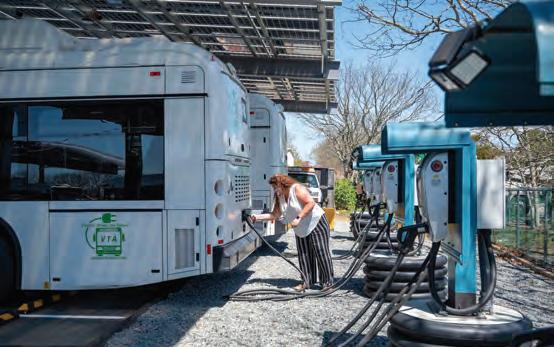

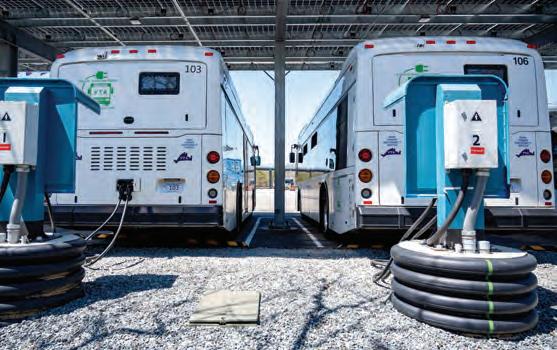
“Liz, perhaps more than anyone I know, embodies the true spirit of partnership.”
–Tom Chase, Nature Conservancy and BiodiversityWorks
Climate Planner for the Martha’s Vineyard Commission

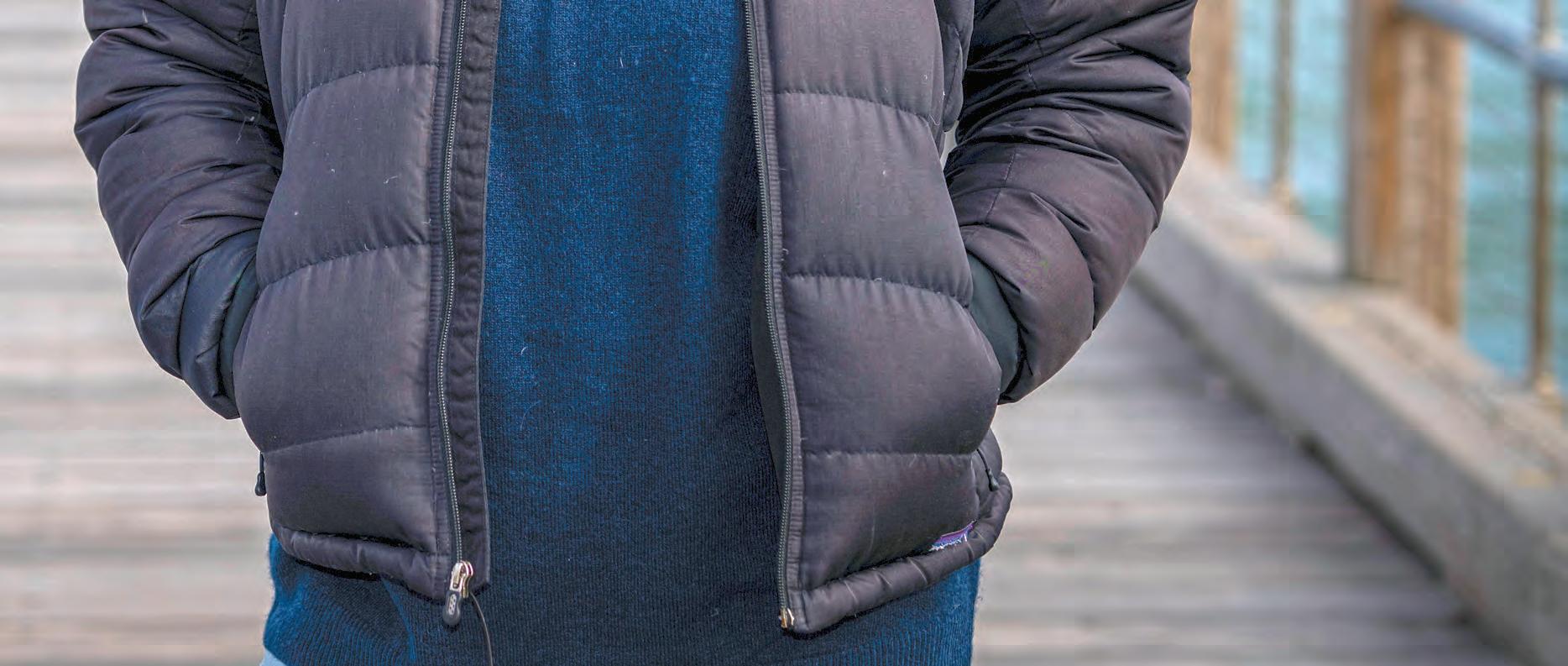
Turning climate challenges into local opportunities
Story By Lucas Thors Photo By Jeremy DriesenSince the first time Liz Durkee stepped off the boat onto the Steamship Authority pier as a kid, she knew she wanted to live on Martha’s Vineyard. Her parents met and married on the Island, and Liz, who lives in Oak Bluffs, has been coming to the Island since she was 7 years old. A big part of what drew her back to her favorite vacation spot was the immense natural beauty that persists here: the cool waters containing a rich bounty, and the unique and varied forests
and marshes that span most of the Island. Now, as climate change planner for the Martha’s Vineyard Commission (a post to which she was named earlier this year), she is working to protect the beaches, sprawling vistas, and marshlands that have drawn her all her life.
“I love this Island. I always have, even back when I was a summer kid,” Liz told Bluedot Living. “There was such a sense of freedom and openness, I felt so much more at peace here than anywhere else. It’s very rewarding to have a job at the commission, where I feel like I am helping to protect the things that are so beautiful and that I am so drawn to.”
She was originally drawn to environmental issues through her interest in pre-Columbian history and Native American history, especial-
ly as they related to land use.
“The indigenous populations consider themselves a part of the natural world, not above the natural world, and that really resonated with me,” Liz said.
She studied history in school, and eventually found an outlet for her passion in her former position as the Oak Bluffs conservation agent, focusing on wetlands protection, a job she held for 26 years.

But her interests in coastal sustainability and sea level rise snowballed into a question that she often asks herself: What will the collective impacts of climate change be on Martha’s Vineyard? “I really wanted to understand what was going to happen with these big changes, so maybe we could plan for them, and be prepared,” Liz said.
“When I get interested in a subject, I have to really delve into it, and that’s what happened
Continued on page 63
“She is so incredibly passionate. She loves this Island and the natural environment, and she wants to keep it beautiful and safe for everyone.”
–Joan Malkin, chair of the Martha’s Vineyard Commission



